Introduction
While COVID‑19 is a health emergency, the measures that have been necessary to save lives and preserve capacity in Ontario’s health care system have had serious economic consequences. Overwhelmingly, the people and employers of Ontario have been willing to do what it takes to protect each other, even when these sacrifices have impacted their livelihoods. Ontario recognizes this sacrifice and is taking additional steps to provide direct support to families, workers and small businesses through measures outlined in Ontario’s Action Plan: Protecting People’s Health and Our Economy.
Few have sacrificed more than the owners and employees of the tens of thousands of small businesses affected by the public health measures put in place to stop the second wave of COVID‑19. In December, the government announced the Ontario Small Business Support Grant, which is providing a minimum of $10,000 and a maximum of $20,000 to help eligible small businesses. Based on applications received as of mid-March, the government estimates that approximately 120,000 small businesses will benefit from $1.7 billion in relief through this grant, at a time when it is most needed.
While this relief has made it possible for many employers to remain in business, many are continuing to struggle and will face new expenses as restrictions are lifted. This is why Ontario is automatically providing a second round of support to small businesses that have already been deemed eligible for the Ontario Small Business Support Grant. This brings the total amount of relief being delivered through the grant to a projected $3.4 billion.
Even with the unprecedented support the government has provided, many workers have lost their jobs due to the COVID‑19 pandemic. Each job lost is much more than an economic statistic — it represents an anxious mom or dad, a family struggling to make ends meet, or a young person facing an uncertain future. And some have been impacted more than others. Women, racialized communities, lower income workers and employees in industries like hospitality and tourism have been disproportionately affected.
To help these workers get back into the workforce as quickly as possible, Ontario is connecting them with jobs in industries that are hiring. A key part of this effort is the proposed temporary Ontario Jobs Training Tax Credit, which would provide up to $2,000 to individuals with eligible training expenses in 2021. This measure alone would provide about $260 million in support to 230,000 Ontario individuals.
Parents have also shouldered an incredible burden during the COVID‑19 pandemic, balancing the stress of unprecedented changes in schooling with the pressures of providing and caring for their children. Many families have incurred additional expenses for child care, learning technologies and safe activities during COVID‑19, while others have been held back from working due to the impact of public health restrictions.
Supporting moms and dads is in everyone’s interest, which is why the government is providing significant relief to parents with $1.8 billion in direct payments as part of the Ontario COVID‑19 Child Benefit. The Province is automatically providing a third round of payments to parents who received Support for Learners payments, which are now being doubled. Every eligible parent will receive $400 for each child aged 0 to Grade 12, and $500 for children and youth 21 years old or younger with special needs. Parents who had not applied for the previous payments will be able to submit an application for this third payment round. This unprecedented support is estimated to provide families $980 million in relief on an urgent basis. This is in addition to the $868 million in payments the government already provided to support parents in response to the COVID‑19 pandemic.
To provide additional support to parents for child care expenses, the government is proposing a 20 per cent top-up to the Childcare Access and Relief from Expenses (CARE) tax credit for 2021. This would increase support for parents from $1,250 to $1,500, on average. Total support provided by this temporary top-up would be about $75 million, and will help parents get back into the workforce and help make child care more affordable during this tough period.
While no one could prevent a global pandemic, people in Ontario understand that their personal actions can lower the risk of COVID‑19 for their families and communities. While these sacrifices have come at a cost, Ontario will continue to be there with support for people and jobs until we can put this difficult period behind us.
These supports will be complemented by measures that will help drive Ontario’s recovery from the pandemic, build on the province’s strong economic foundation and drive future economic growth. When that time comes, the government will take further steps to create a more competitive environment for job creators through a plan for long-term economic growth, informed by business leaders and entrepreneurs, workers and labour representatives, community organizations, experts and most importantly, the people of Ontario.
I really believe that Ontario will come out stronger. We can’t have a healthy economy without healthy people. We’re going to do everything it takes to keep people safe and healthy. But we’re also going to do everything we can to have the healthiest economy in all of North America.
The Honourable Peter Bethlenfalvy
Minister of Finance and President of the Treasury Board
Ontario’s Action Plan: Protecting People’s Health and Our Economy brings the government’s total investment to protect Ontario’s economy to $23.3 billion.
Supporting Workers and Families

Workers and families are the heart and soul of Ontario. COVID‑19 has come at a significant cost to their livelihoods, which is why Ontario is providing unprecedented support for them.
Providing Ontario Families Relief
Strong families make for a strong province. But COVID‑19 has made life more difficult for parents and kids across the province.
Supporting Families through the Ontario COVID‑19 Child Benefit
The additional costs of virtual learning, reduced access to after school programs and child care, barriers to getting back to the workplace, and the stress of the necessary public health restrictions mean families need and deserve relief.
This is why, to help strengthen families and make life a little easier, the government is providing another round of direct payments to parents through the Ontario COVID‑19 Child Benefit. The Province is automatically providing a third round of payments to parents who received Support for Learners payments, which are now being doubled. Every eligible parent will receive $400 for each child aged 0 to Grade 12, and $500 for children and youth 21 years old or younger with special needs. Parents who had not applied for the previous payments will be able to submit an application for this third payment round. This unprecedented support is estimated to provide families $980 million in relief on an urgent basis. This is in addition to the $868 million in payments the government already provided to support parents in response to the COVID‑19 pandemic.
Through the total support of over $1.8 billion in direct payments as part of the Ontario COVID‑19 Child Benefit, the government is recognizing that families face unique pressures from the COVID‑19 pandemic.
Choice and Affordability in Child Care
COVID‑19 has taught us a lot of things, but one critical thing it’s showed us is how important child care is to a functioning economy.
Frances Donald
Chief Economist and Head of Macro Strategy,
Manulife Investment Management
“The Economy Can’t Recover until Parents Have Child Care Again,” CNN Business
The government recognizes that parents are best placed to make decisions about their children’s care. This is why, in 2019, the government introduced the Childcare Access and Relief from Expenses (CARE) tax credit, which helps Ontario families with child care costs while letting them choose the care that is right for their children.
With the COVID‑19 pandemic and as a result of temporary school closures, parents have faced challenges in their careers. Many have had to leave the workforce and will struggle to rejoin it. Unaffordable child care should not be a barrier to getting back to work.
To further support families, the government is proposing a temporary, 20 per cent top-up to the 2021 entitlement of the CARE tax credit for all recipients. The top-up would increase support by $75 million or from about $1,250 to about $1,500 per family, on average, to help more than 300,000 families who are eligible for the credit with their 2021 child care expenses.
While COVID‑19 has impacted everyone, women in the workforce have been disproportionately affected, as many of the sectors that suffered heavy job losses and are experiencing a slower recovery are female dominated. Supporting increased participation by women in the workforce will be critical to Ontario’s economic recovery, and having access to affordable child care will be a key factor in enabling that participation.
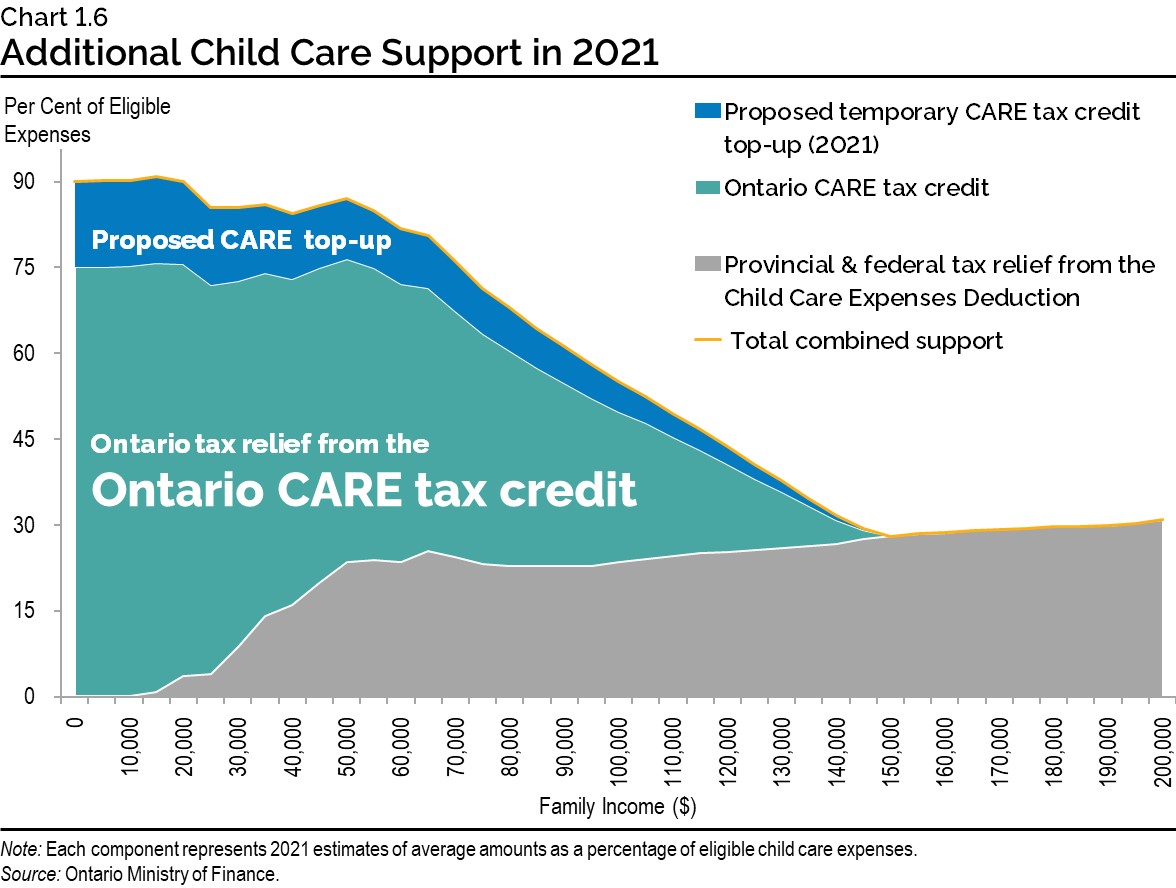
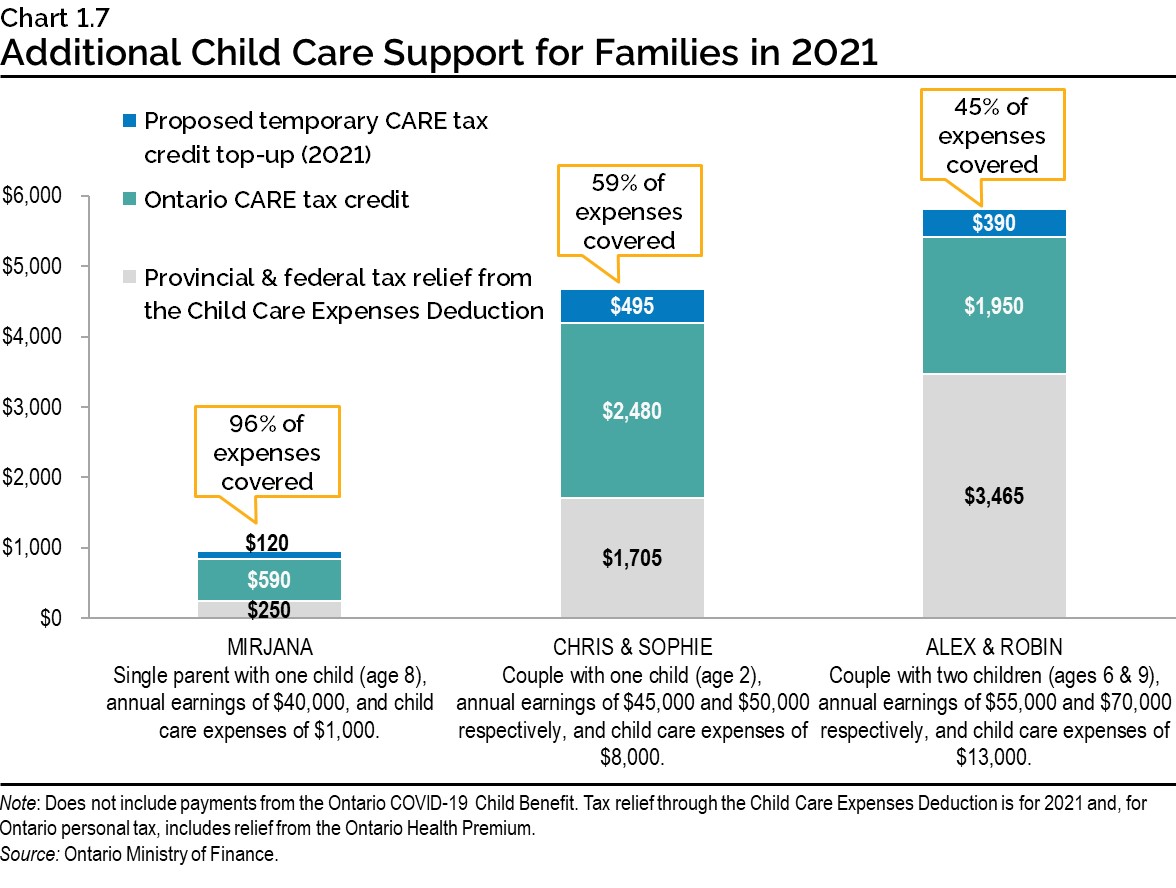
See Annex: Details of Tax Measures and Other Legislative Initiatives for further information.
Creating Child Care Spaces
Ontario is also building more child care spaces. The government has committed to creating up to 30,000 new child care spaces, including up to 10,000 spaces in new schools. As of winter 2021, over 20,000 new spaces have been approved, which will support families and ensure a strong and accessible child care system.
Ontario also provided targeted emergency child care to frontline workers at no out-of-pocket cost prior to the return to in-person learning. In 2021, this provided over 39,000 child care spaces across 545 sites for frontline workers, including grocery store and health care workers, as well as those working with vulnerable populations.
Together, along with the proposed enhancement of the CARE tax credit, these investments help parents remain in or re-enter the workforce by making child care more accessible and affordable during this challenging period.
However, while Ontario is taking steps to improve child care access, affordability and choice, it cannot act alone. As the federal government pursues discussions with the provinces and territories on its proposed national child care strategy, Ontario encourages the federal government to adopt the following principles that are critical to success:
- Improved child care access, affordability and choice for families;
- Flexibility for provinces and territories as the needs of children and families vary across regions and communities; and
- Increased and sustained federal funding for child care.
Ontario has made considerable progress in improving child care and Ontario looks forward to working with the federal government to improve child care options for parents and deliver results for the province’s families and the economy.
Setting Workers Up for Success
The COVID‑19 pandemic has had a significant impact on Ontario’s labour market and some of its impacts may be long-lasting. Many workers lost their jobs and are still unemployed. This is why Ontario is providing a range of training and employment supports, many of which are streamlined and digitized, to ensure workers have the skills required to support economic recovery.
Ontario’s post-secondary institutions can harness a range of flexible education models in an effort to meet growing demand from working-age lifelong learners who increasingly need to access training and upskilling opportunities for a changing labour market. Labour market disruptions caused by the ongoing pandemic will only serve to accelerate this trend.
André Côté and Alexi White
“Higher Education for Lifelong Learners:
A Roadmap for Ontario Post-Secondary Leaders and Policymakers”
Ontario 360
Helping Workers with the Cost of Training
To help workers get the training they need, the government is introducing the proposed Ontario Jobs Training Tax Credit. This would be a temporary, refundable Personal Income Tax credit that would deliver support for 2021. The credit would provide up to $2,000 in relief for 50 per cent of eligible expenses.
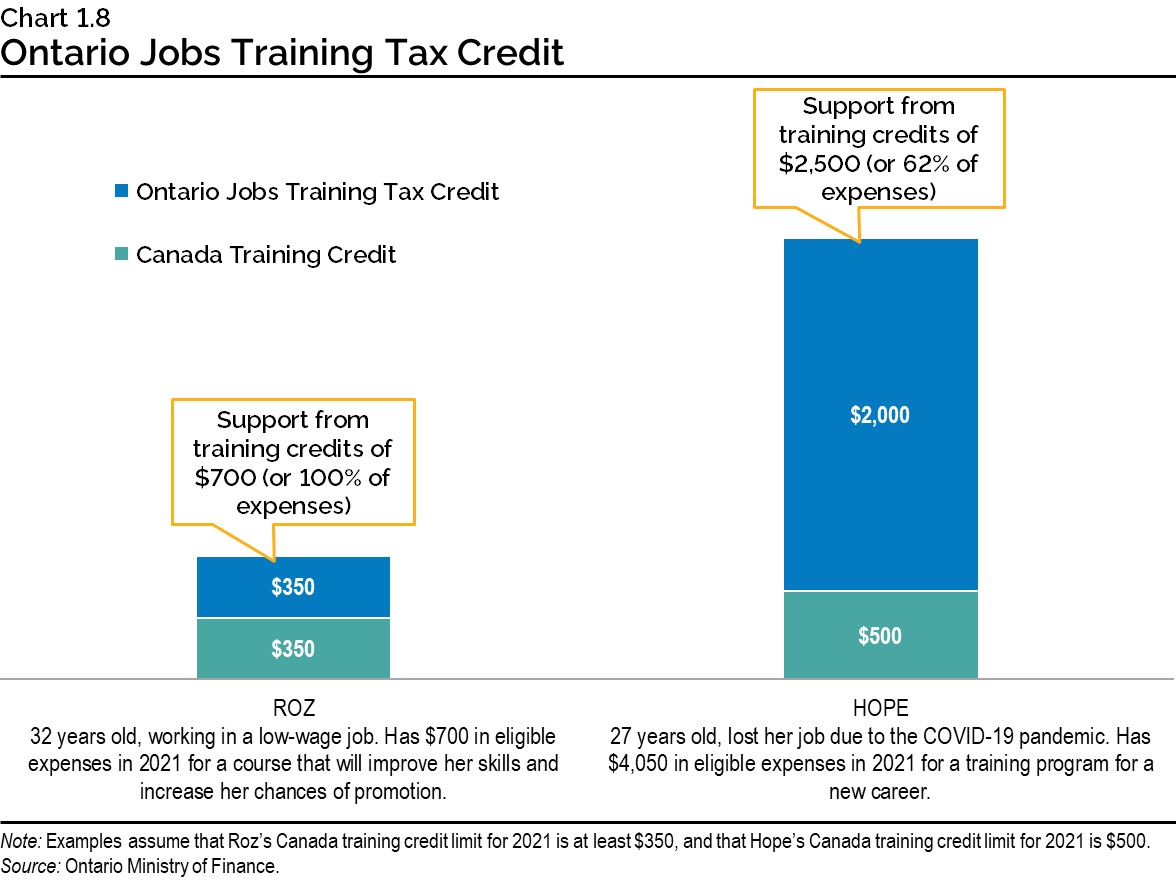
The Ontario Jobs Training Tax Credit would provide an estimated $260 million in support to about 230,000 people in 2021, or about $1,100 on average.
To claim the proposed credit, individuals would have to have a positive Canada training credit limit for 2021. See Annex: Details of Tax Measures and Other Legislative Initiatives for further information and conditions for receiving the credit.
Providing Employment and Training Supports – COVID‑19 Response
Ontario continues to support workers hardest hit by the COVID‑19 pandemic by investing an additional $614.3 million during 2020–21 and 2021–22 to provide targeted employment and training supports. This includes up to:
- $85.0 million to support the Skills Development Fund to help training and employment organizations assist workers during the province’s economic recovery. The funded projects will give laid-off workers immediate access to training supports or new jobs, improve the quality of training, support traditionally underrepresented groups, increase apprentice registrations and completion, better serve local communities and support the talent needs of small businesses. These additional funds will bring the government’s investment up to $115 million.
- $117.3 million to assist women, racialized individuals, Indigenous peoples, youth and people with disabilities who are facing the highest rates of unemployment during the pandemic. This funding will help remove barriers and offer training opportunities so they can get the in-demand skills they need for good jobs and get connected with employers looking to grow their businesses.
- $157.2 million to provide workers in the hardest hit sectors during the pandemic — including the hospitality and tourism sectors — with career counselling and urgent training to find new careers and good jobs. This support will be provided by Employment Ontario’s range of client services and community development programs.
- $60.8 million to upgrade and expand high-speed internet and other digital infrastructure so community organizations, training providers and colleges can provide employment and training services remotely to workers in every corner of the province, including rural, remote and Northern regions.
- $194 million to further support Ontario workers with additional employment and training programs and services that are responsive to the province’s economic recovery.
These investments reflect increased funding provided by the federal government under the Canada-Ontario Workforce Development Agreement. Ontario welcomes this time-limited additional funding. However, increased flexibility and longer-term funding is critical to support economic recovery and longer-term growth.
Developing a Digital Strategy for Job Seekers
Ontario recognizes the importance of digital services and is looking to modernize its approach to training and skills development, especially during COVID‑19 when in-person interactions are limited. The government is investing an initial $5 million this year to develop a new, modern suite of digital services to complement the in-person services delivered through Employment Ontario. This digital strategy will help job seekers get the right information, tools and services, and will help employers more easily find the talent they need.
Developing a Virtual Skills Passport
The COVID‑19 pandemic has caused a significant transformation in workforce demands, creating both the need and opportunity for workers to rapidly learn new skills and improve existing ones. To provide Ontario students and workers with a faster pathway to employment, the government launched its first micro-credentials strategy in fall 2020, investing $59.5 million over three years. As part of the strategy, the government is providing additional one-time funding of $2 million in 2021–22 for the development of a virtual skills passport that tracks learners’ credentials to set the foundation for lifelong learning, and allows them to share credentials digitally with prospective employers.
Launching Ontario’s Workforce Recovery Advisory Committee
To position Ontario as one of the top jurisdictions with a world-class workforce and talent supply, the government is establishing an Ontario Workforce Recovery Advisory Committee led by workforce and industry experts. Its mandate will focus on economic recovery, strengthening Ontario’s competitiveness and supporting workers
Building Opportunities in the Skilled Trades
Enhancing the Skilled Trades Strategy
To help rebuild Ontario’s economy, there will be a need for more skilled workers. This is why the government is continuing to modernize and evolve the skilled trades and apprenticeship system by way of the Skilled Trades Strategy that was announced in the 2020 Budget.
The government’s prioritization of promoting careers in construction through increased awareness to students, guidance counselors, and parents is appreciated and is a step in the right direction to getting more young people interested in the skilled trades.
Richard Lyall
President
Residential Construction Council of Ontario
Ontario is investing a total of $288.2 million in 2021–22 in its Skilled Trades Strategy, which includes the following enhancements:
- Providing an additional $39.6 million over three years, beginning in
2021–22, to expand the Specialist High Skills Major program. Building off an investment of $42.4 million in 2020–21, this will result in approximately 75 new programs that provide more opportunities for students in Grades 11 and 12 to gain job‑ready skills and explore opportunities in the skilled trades. - Investing $3 million over three years in a new pilot bursary program for hands-on learning in the skilled trades. Starting in 2021–22, this bursary will support approximately 1,000 students with financial and other barriers to obtain their Ontario Secondary School Diploma. This program includes participation in a cooperative education course focused on the skilled trades.
- Expanding the Ontario Youth Apprenticeship Program (OYAP) to include a Grade 10 summer learning opportunity, starting in 2021. OYAP allows students in Grades 11 and 12 to gain exposure to a variety of good jobs in the skilled trades through cooperative education placements, while earning credits towards their high school diploma.
Ensuring Enough Skilled Trades Workers for Infrastructure Projects
To ensure that Ontario has the skilled labour it needs for priority infrastructure projects, proponents of the Ontario Line subway project will provide information on in-demand trades and subtrades necessary to support project completion in their response to the Request for Proposals (RFPs). The successful proponent will enter into discussions with the Ontario Ministry of Labour, Training and Skills Development regarding apprenticeship training supports, including strategic voluntary targets and financial incentives.
Supporting Students
The COVID‑19 pandemic has changed how education is delivered. Ontario is making investments to ensure students continue to learn throughout the COVID‑19 period and acquire the skills they need for the jobs of the future.
Improving Remote and Online Learning
Connectivity is critical for students and teachers. This is why Ontario is investing $40 million in new funding over two years to improve remote learning technology. This investment will help improve connectivity within school buildings and provide innovative tools and resources to help ensure that students and teachers can seamlessly participate in remote learning in response to COVID‑19, and for the future.
Building Schools

Investments in schools are investments in the future and contribute to the long-term economic prosperity of the province. This is why the government is investing about $14 billion in capital grants over 10 years to build more schools, upgrade existing facilities across Ontario and support education-related projects. This includes $1.4 billion in school renewal for the 2021–22 school year, which will ensure excellent learning environments. These investments will provide students with a solid foundation that will help set them up for lifelong success.
Students deserve to learn in safe, digitally connected and accessible environments. As part of the government’s ongoing efforts to improve and modernize infrastructure, Ontario is investing $550 million in the 2020–21 school year to build 20 new schools and eight permanent additions to existing schools. These new projects will create nearly 16,000 new learning spaces and will ensure that students and staff have access to the best classrooms and learning environments. During construction, these new projects will also create hundreds of jobs and contribute significantly to Ontario’s economic recovery.
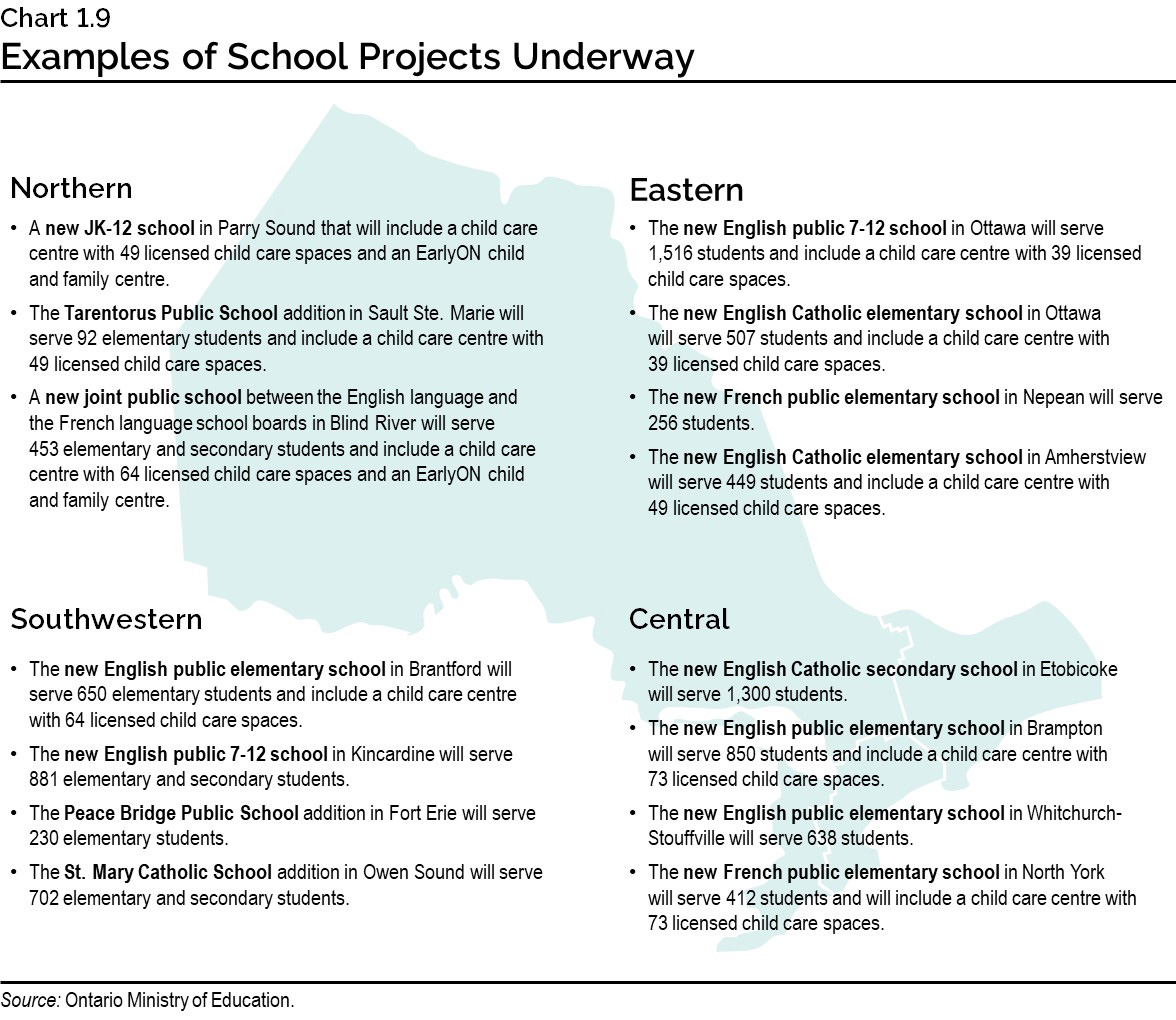
Making Postsecondary Education More Affordable
The COVID‑19 pandemic has had a disproportionate impact on youth and students, many of whom may have faced setbacks in their studies over this time period. Ontario made postsecondary education more affordable with a historic 10 per cent reduction in tuition fees for Ontario students at every publicly funded college and university in all funding-eligible programs in the 2019–20 school year, and by freezing tuition fees for the 2020–21 school year.
The government is also expanding the Ontario Student Assistance Program (OSAP) to ensure that more students and learners have access to postsecondary education in order to prepare them for the labour market. Starting in the 2020–21 academic year, students in eligible programs at Indigenous Institutes can apply for financial assistance through OSAP. Ontario is also extending OSAP eligibility to students enrolled in ministry-approved, quality-assured micro-credential programs.
Investing in Postsecondary Education Institutions
In 2021–22, the government will be providing base operating grant funding of $3.6 billion to Ontario’s 21 publicly funded universities and $1.4 billion to Ontario’s 24 publicly funded colleges. These funds will be used for general operating expenses, including program delivery, student services and staffing.
To help address the financial challenges related to COVID‑19 and support Ontario students, the government is providing an additional $106.4 million in 2020–21 to postsecondary institutions. This funding will support postsecondary institutions with the greatest financial need and could be used in key areas experiencing pressures related to COVID‑19, including program delivery and student financial aid.
Ontario will continue to support postsecondary institutions by investing $90 million over three years to help colleges and universities renew and purchase modern, state-of-the-art equipment. In addition, Ontario is also establishing a new training equipment renewal fund for universities. This funding will help students to obtain the skills they need for the in-demand jobs of today and tomorrow. It will also support postsecondary institutions in delivering relevant, high-quality training to ensure that graduates meet the needs of Ontario’s labour market, including increased access to micro-credentials. These programs will partner with the private sector to meet evolving employer needs.
We’re pleased the government continues to demonstrate such strong support for colleges…. We’re excited to be collaborating with the government on further measures to modernize post-secondary education, including creating more opportunities for people who need to retrain for new careers during Ontario's economic recovery.
Linda Franklin
President and CEO
Colleges Ontario
Ontario is also investing $493 million in capital funding over three years, starting in 2021–22 to help colleges and universities across Ontario address the ongoing need for the maintenance, renovation and modernization of their facilities. The world-class education that students receive at postsecondary institutions is critical to the future of Ontario and to support our economic recovery. These improvements will allow students, faculty and staff to confidently continue to learn and teach in an environment that is modern and safe.
Expanding Virtual Learning
The government’s historic investment in the Virtual Learning Strategy, or VLS, is helping to usher in a new era for the postsecondary education sector.
Robert Luke
Chief Executive Officer
eCampusOntario
The COVID‑19 pandemic has highlighted the importance of flexible and accessible virtual learning to help all learners acquire the skills they need to succeed. To help expand access to high‑quality, in demand, globally competitive virtual education, the government announced the investment of $50 million in a new Virtual Learning Strategy in December 2020. To support its implementation, Ontario will be providing an additional $21.4 million over two years, beginning in 2021–22.
Supporting Jobs

Ontario is supporting employers most severely impacted by COVID‑19 through programs such as the Ontario Small Business Support Grant, Main Street Relief Grant for Personal Protective Equipment (PPE) support, and property tax and energy cost rebates. Through Ontario’s Action Plan: Protecting People’s Health and Our Economy, the government is taking further steps to provide immediate and significant supports to employers most impacted by COVID‑19. This support will help businesses recover, weather the pandemic and continue to create jobs and prosperity for years to come.
Helping Small Businesses Survive COVID‑19
Small businesses are the backbone of Ontario’s economy, employing local people in communities across Ontario. To help small businesses that were required to close or significantly restrict services under the provincewide shutdown that came into effect in December 2020, Ontario launched the Ontario Small Business Support Grant in January 2021, which provides a minimum of $10,000 and a maximum of $20,000 to help eligible small businesses. Based on applications received as of mid‑March, the government estimates that approximately 120,000 small businesses will benefit from $1.7 billion in relief through this grant, at a time when it is most needed.
Doubling the Ontario Small Business Support Grant
While some restrictions have been lifted and certain businesses can now safely reopen, the severe economic impacts of the COVID‑19 pandemic persist for many small businesses.
Protecting these vital employers in Ontario communities is an urgent priority, which is why the government is announcing that an additional round of support will be provided through the Ontario Small Business Support Grant. Small businesses who have been determined as eligible recipients of the Ontario Small Business Support Grant will automatically be entitled to a second payment in an amount equal to the first payment they received. They will not need to apply again to receive this additional funding.
Through these two rounds of support, it is projected that the Ontario Small Business Support Grant will deliver an estimated $3.4 billion to approximately 120,000 small businesses in Ontario, helping them through this difficult time and protecting jobs.
Enhancing the Digital Main Street Program
In June 2020, Ontario, in partnership with the federal government, announced the Digital Main Street platform, a $57 million program designed to help up to 22,900 Ontario businesses create and enhance their online presence. Digital Main Street is helping businesses expand their digital footprint and extend their reach into new markets. To date, the program has been able to provide close to 20,000 Main Street small businesses with support for their digital expansions. The program will also generate jobs for more than 1,400 students.
In the 2021 Budget, Ontario is investing an additional $10 million in the Digital Main Street program in 2021–22 to help more small businesses achieve a digital transformation and serve customers effectively online. The program will continue to provide digital transformation grants, an online learning platform, training programs, and Digital Service Squads offering technical support to small business owners.
Providing Additional Support to Ontario’s Small Businesses
Other supports the government has already introduced that will support small businesses include:
- Helping eligible small businesses with the unexpected costs of PPE with one‑time grants of up to $1,000 through Ontario’s Main Street Relief Grant.
- Partnering with the federal government to provide $976 million in urgent rent relief through the Canada Emergency Commercial Rent Assistance (CECRA) for small businesses program. In addition, the government has extended the temporary ban on commercial evictions for those business tenants that are approved for the federal Canada Emergency Rent Subsidy (CERS).
- Providing property tax and energy cost rebates to help eligible businesses in the Control, Lockdown or Provincewide Shutdown regions (or previously in Modified Stage 2 regions).
- Providing $8 million for the COVID‑19 Energy Assistance Program for Small Business to support businesses struggling with bill payments as a result of the COVID‑19 outbreak.
- Providing about $320 million in additional relief in 2020–21 through off‑peak electricity pricing, 24 hours a day, for eligible residential, farm and small business customers during periods of provincial restrictions from March 24, 2020 to May 31, 2020, and January 1, 2021 to February 22, 2021.
In addition, Ontario cut its small business Corporate Income Tax (CIT) rate to 3.2 per cent starting in 2020, fulfilling the commitment to cut the small business CIT rate by 8.7 per cent. This measure delivers up to $1,500 in annual savings to Ontario businesses that benefit from the small business CIT rate.
Ontario has also lowered high Business Education Tax (BET) rates for job creators and is continuing to deliver the Ontario Electricity Rebate, which provides direct relief on eligible residential, farm and small business electricity bills, in addition to removing a portion of the cost of high price renewable energy contracts as part of Ontario’s comprehensive plan to provide electricity price relief.
To illustrate measures that are providing assistance to Ontario’s businesses significantly impacted by COVID‑19, consider the example of a small retail store in Markham shown in Chart 1.10. During the first three months of 2021, the retailer could be eligible for $59,325 in Ontario and federal relief.
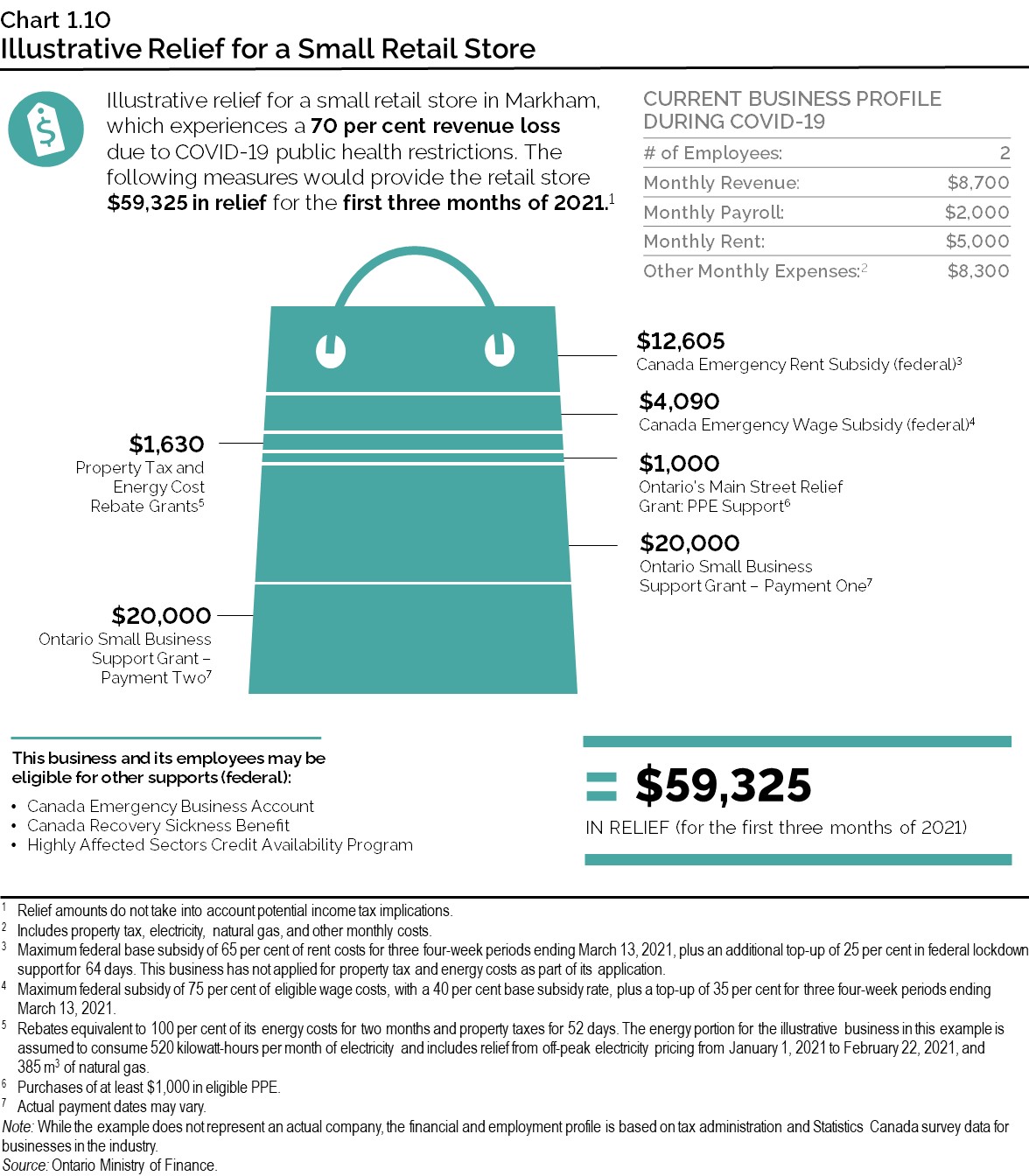
Ontario’s Support Strategy for Tourism, Hospitality, Culture and Sports
Ontario’s tourism, hospitality, culture, sports and recreation sectors have been among the most heavily impacted by the COVID‑19 pandemic. Tourism and hospitality‑related industries experienced a total combined loss of 140,1001 jobs between February 2020 and 2021.
In response to the unique challenges these sectors are facing, Ontario is announcing a wide range of initiatives to help the tourism, hospitality and culture sectors survive the COVID‑19 pandemic and thrive in the future. In the 2021 Budget, Ontario is investing more than $400 million over the next three years in new initiatives to support these sectors. This builds on investments of $225 million announced earlier, bringing the total to more than $625 million since the pandemic began.
Introducing the Ontario Tourism and Hospitality Small Business Support Grant
Ontario recognizes that there are many businesses in the tourism and hospitality sector that require support to get through this difficult time. This is why the government is introducing the new Ontario Tourism and Hospitality Small Business Support Grant, which will provide an estimated $100 million in one‑time payments of $10,000 to $20,000 to eligible small businesses.
As they look ahead to the upcoming spring and summer tourism season, these eligible small businesses can apply for support to help them recover from the impacts of COVID‑19 as well as to help create and protect jobs. Businesses must demonstrate they have experienced a minimum 20 per cent revenue decline and have less than 100 employees to qualify. Applying online will be easy. Further details can be obtained at Ontario.ca/COVIDsupport.
Any small businesses that received the Ontario Small Business Support Grant will not be eligible for this new grant.
Helping Ontario’s Tourism Industry Recover and Rebuild
Ontario is introducing the Ontario Tourism Recovery Program, a new $100 million initiative for 2021–22 to help tourism operators, anchor businesses and attractions recover from the impacts of COVID‑19. This initiative will provide support for historically successful businesses that have helped to drive employment and visitation in their regions by assisting with costs related to restructuring, safe reopening, recalibrated marketing activities and partnership development.
Encouraging Residents to Vacation within Ontario when it is Safe
Public health and safety measures aimed at containing the spread of COVID‑19, while necessary, have affected tourism across Ontario. In the 2020 Budget, the government announced that it would explore ways to provide Ontario residents with support of up to 20 per cent for eligible Ontario tourism expenses to encourage them to discover the province in 2021. To this end, the government has set aside $150 million and intends to introduce legislation for a tax credit to encourage residents to explore Ontario when public health experts advise that it is safe to travel.
Supporting Ontario’s Regional Tourism Organizations
Ontario is committing to supporting tourism across the province through increased funding of up to $15 million for the Regional Tourism Organizations (RTOs) in 2021–22. The initiative will help stabilize and support the tourism sector’s efforts to attract domestic and international visitors when it is safe to do so. It will support the continued operation of Destination Toronto, Ottawa Tourism, and the 11 additional RTOs for the recovery of regional tourism, and to maintain and produce new, innovative tourism services and experiences under a modernized mandate.
Standing Behind Ontario’s Arts Community
To support the arts sector during COVID‑19, the government is increasing its investment in Ontario’s arts community by $10 million in 2021–22. With support from the Ontario Arts Council (OAC), this increased investment will assist with significant costs incurred when preparing for activities and events that could not go forward in 2020–21. It will also help with financial impacts that occurred from the loss of box office revenue and venue rental income, as well as new costs related to health and safety, and digital or virtual programming. This new investment will help arts organizations throughout the province adapt their programming as they rebuild their audience, membership and donor bases. It will also support jobs at the local level for musicians, writers, painters, actors, dancers, stagehands and many others who support Ontario’s arts and culture industry.
Providing More Opportunities to Enjoy Ontario Parks
Parks and conservation reserves have been places of safe recreation during the pandemic. As people look for more opportunities to safely enjoy the outdoors, Ontario is encouraging visits to provincial parks by offering free day‑use entry on Mondays through Thursdays, from May 1 to September 2 this year. This will help more people and families enjoy outdoor activities such as canoeing, hiking and bike riding in provincial parks.
Ontario will also invest an estimated $3.9 million over three years to enhance the provincial park experience by using technology to better connect the people of Ontario with a one‑stop shop to help them find recreational opportunities that fit their location and interests. The province and local businesses will collaborate to develop ideas to bolster Ontario’s tourism economy and create new ways to enjoy provincial parks.
Providing Financial Relief for Resource‑Based Tourism Businesses
Ontario is providing targeted support for resource‑based tourism businesses that have been impacted by the COVID‑19 pandemic. Eligible Commercial Outpost Camps and hunting and fishing outfitters would receive another year of relief from certain rents and fees, providing approximately $1.3 million in financial assistance. This relief will help with the recovery of the sector by supporting businesses that employ residents and contribute to local communities.
Investing in Sport and Community Infrastructure
Ontario is investing around $200 million to provide infrastructure funding to larger, strategic projects and to sports facilities through the newly established Strategic Priorities and Infrastructure Fund. This fund will help address some of the unmet demand under the Community, Culture and Recreation stream of the Investing in Canada Infrastructure Program (ICIP), which received more applications than could be funded under that program. The fund will also support the sport and recreation sector, which was one of the hardest hit sectors during the COVID‑19 pandemic.
The Strategic Priorities and Infrastructure Fund is delivered through two streams. The Priority Local Infrastructure stream will support new build multi‑purpose facilities for community, culture and recreation purposes.
The Sport and Community Renewal stream provides funding to support the renovation and rehabilitation of sport and community infrastructure.
Supporting Restaurants and Bars

During the COVID‑19 pandemic, the Ontario government is supporting jobs in the hospitality sector by:
- Permanently allowing licensed restaurants and bars to include alcohol with food as part of a takeout or delivery order to help restaurants, bars, breweries, wineries and distilleries rebuild and recover. This is one more step in the government’s work to ensure choice and convenience for consumers.
- Helping to offset the costs of purchasing PPE with up to $1,000 in financial support. Eligible small businesses in the accommodation and food services sector can apply for support through the Main Street Relief Grant.
- Permanently allowing off-peak deliveries to retail stores, restaurants, hotels and distribution facilities to help ensure that shelves stay stocked, and businesses can operate efficiently.
- Helping small and independent restaurants during COVID‑19 where indoor dining is prohibited by capping the fees charged by food delivery companies.
Chart 1.11 illustrates provincial and federal relief that may be available to a restaurant for the first three months of 2021.
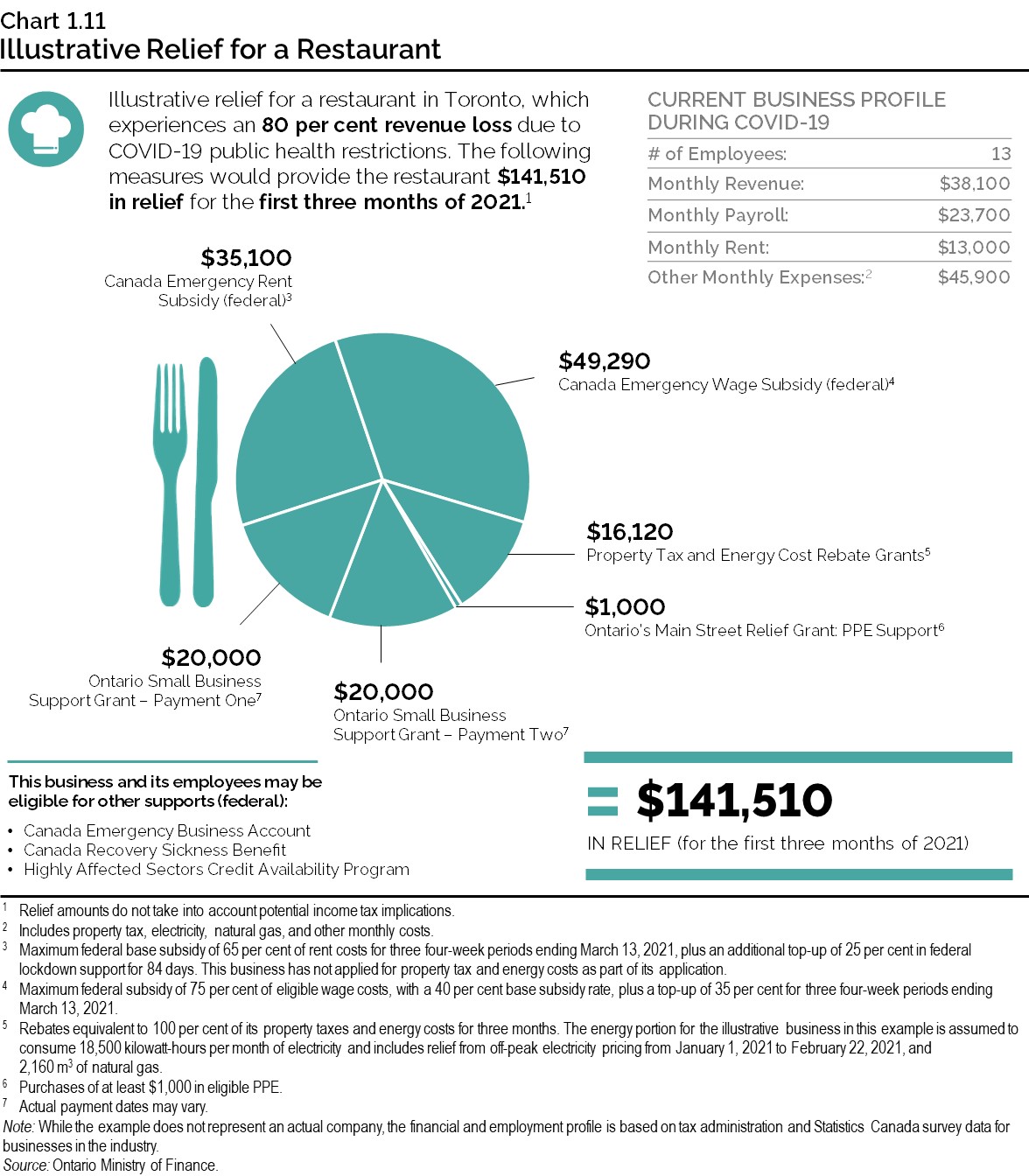
Supporting Local Alcohol Producers
Ontario’s rural communities and local agri‑tourism businesses have been severely impacted as a result of the COVID‑19 pandemic. These include wineries that had to cancel tours, tastings, weddings and other events that these businesses rely on.
The Ontario government made a number of changes to support local beverage alcohol producers, including expanding made in Ontario options at the LCBO and changes to permit the sale of 100 per cent Ontario wine and eligible spirits at farmers’ markets. The government will also permit the sale of Ontario beer at farmers’ markets for the upcoming season.
To support the recovery and sustainability of Ontario’s wine and agri‑tourism industry, the government is providing a one‑time $10 million grant in 2021 to help wineries and cideries impacted by lockdown measures, and help ensure that agricultural production and local jobs are maintained in Ontario’s rural communities.
The government is also increasing funding for the Small Distillery Support Program by an additional $1.2 million in 2021–22 to help small distillers recover from the impacts of the COVID‑19 pandemic.
In addition, the government is extending the funding to 2022–23 for the following programs:
- VQA Wine Support Program ($7.5 million);
- Small Cidery ($1.8 million) and Small Distillery Support Programs ($0.8 million); and
- Marketing, Tourism and Export Development; Performance Measurement and Research and Innovation Development Initiatives ($5.3 million).
Attracting Business Investment through Invest Ontario
Positioning the province as a top‑tier destination for investment and job creation is critical to supporting long‑term economic growth. In the global economy, however, there is an increasingly fierce competition among jurisdictions to attract business investments. To help make Ontario more competitive and transform its approach to business attraction, the government has created Invest Ontario.
Invest Ontario will promote the province as a key investment destination, making Ontario more competitive, sending a strong signal to investors that Ontario is open for business. It will be a “one‑stop” shop for businesses and investors. And it will move at the speed of business and drive greater economic growth, support strategic domestic firms and attract businesses from around the world to create good jobs in Ontario.
As part of the 2021 Budget, the government is committing $400 million over four years to create the Invest Ontario Fund, which will support Invest Ontario and encourage investments in the key sectors of advanced manufacturing, technology and life sciences. To identify investments in high‑value projects, the agency will rely upon a sophisticated evaluation process to inform its assessments and project selections. The agency will provide expertise and responsive and customizable investor services to support investment opportunities, including available financial assistance, talent support, advisory supports and concierge services.
Invest Ontario will include greater business development and deal structuring expertise and build on the many benefits of investing in Ontario, including a good quality of life, a highly skilled talent pool, a strong and growing innovation sector, and a pro job‑creation climate that can help businesses thrive. The agency will ramp up its operations, staffing and engage the market. Ontario will introduce legislation to continue Invest Ontario, expand its current objects and set out other operational requirements.
In addition to Invest Ontario, the government supports businesses through various other programs and initiatives. For this reason, the Ontario Ministry of Economic Development, Job Creation and Trade is proposing an amendment to the Ministry of Economic Development and Trade Act, 1990. The proposed amendment would require that the outcomes of business support programs be accessible through an annual Ontario Investment Prospectus report. This would improve transparency and accountability by providing timely information regarding public spending and help ensure that funds are used for the benefit of businesses and communities across Ontario.
Building Ontario’s Competitive Advantage
Boosting the province’s economic growth is a crucial precondition for employment, innovation, investment, and higher living standards.
Sean Speer, Drew Fagan, Luka Glozic
University of Toronto
Munk School of Global Affairs and Public Policy
“Grow Ontario Stronger: A Framework for the Ontario Government’s Post Pandemic Recovery Plan”
Prior to the pandemic Ontario had taken a number of significant actions to lower business costs and support economic growth, such as providing Corporate Income Tax relief, cancelling the cap‐and‐trade carbon tax and supporting a reduction in Workplace Safety and Insurance Board (WSIB) premiums.
To support businesses through the COVID‑19 pandemic and into recovery, the government has also:
- Provided further reductions to taxes on job creators, including tax support to encourage investments in certain regions of Ontario that have lagged in employment growth;
- Lowered high Business Education Tax (BET) rates for job creators;
- Made permanent the Employer Health Tax (EHT) exemption increase from $490,000 to $1 million. This will end a tax on jobs for an additional 30,000 employers and save private‑sector employers about $360 million in 2021–22;
- Lowered electricity prices through measures such as the comprehensive electricity plan’s renewables cost shift to save medium size and larger industrial and commercial employers money on their electricity bills; and
- Implemented targeted COVID‑19 measures like the Ontario Small Business Support Grant and property tax and energy cost rebates for eligible businesses impacted by provincial public health measures.
Key cost reduction measures taken since June 2018, combined with new initiatives in the 2021 Budget, are expected to provide $10.2 billion in support to Ontario job creators in 2021, with over 60 per cent of the support going to Ontario small businesses. Support provided to small businesses is estimated at $6.3 billion in 2021.
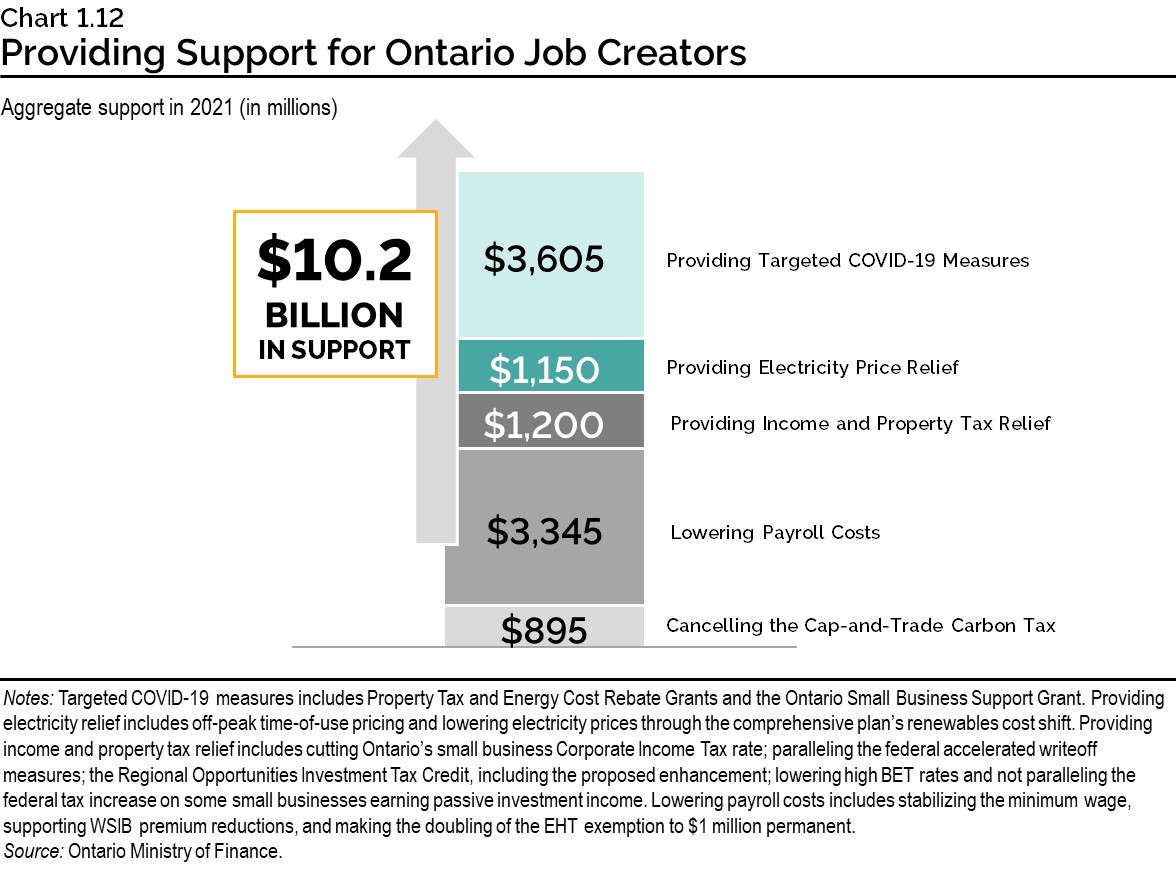
Enhancing the Regional Opportunities Investment Tax Credit
Ontario’s prosperity is built on the strengths of its regional economies. While the province as a whole experienced positive employment growth between the last recession and the outbreak of COVID‑19, the pace of regional labour market growth has varied. Areas in and around Toronto and Ottawa experienced more rapid employment growth compared to the other areas of the province.
To help encourage business investment in areas of the province where employment growth lagged the provincial average between 2009 and 2019, Ontario introduced the Regional Opportunities Investment Tax Credit in the March 2020 Economic and Fiscal Update. This Corporate Income Tax measure is a 10 per cent refundable tax credit for eligible corporations that build, renovate or purchase eligible commercial or industrial buildings in a qualifying region of the province. The geographic areas of the province where investments are eligible are shown in Charts 1.13 and 1.14, and for the complete list, see Annex: Details of Tax Measures and Other Legislative Initiatives.
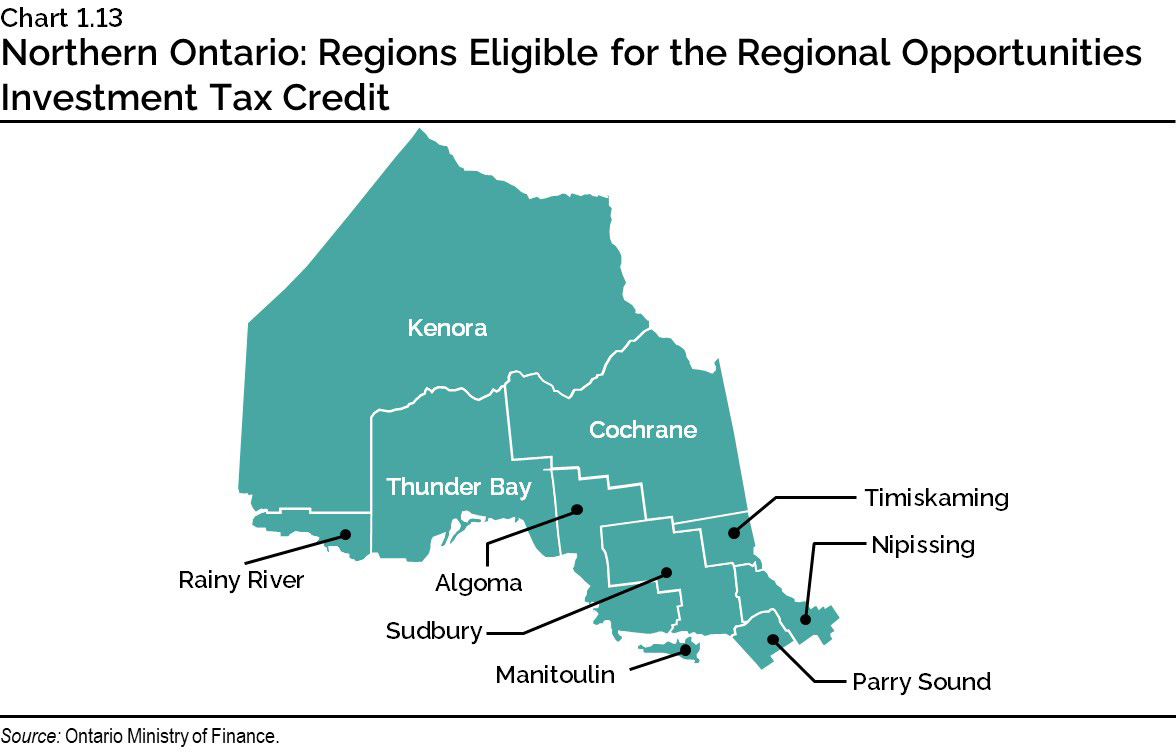
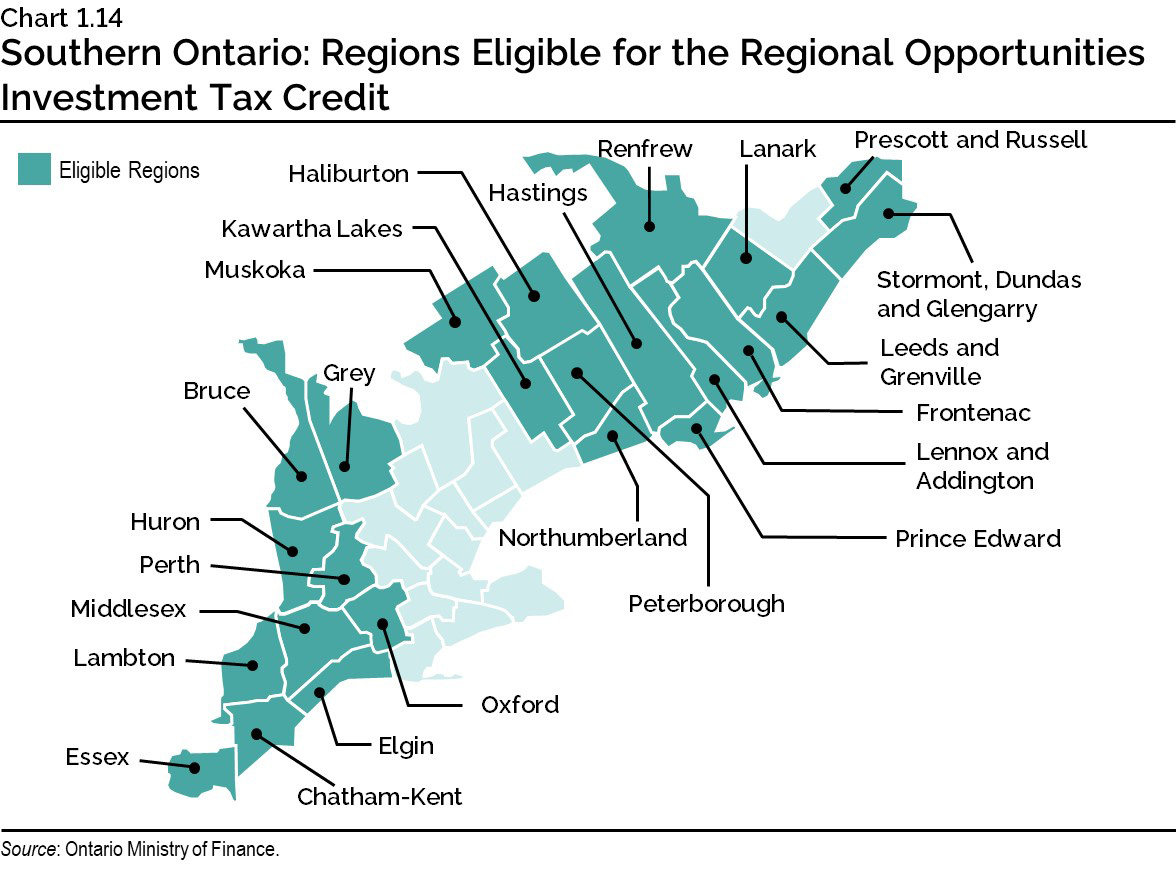
At a critical time when many businesses are looking to re‑open or transition their operations, enhancing the Regional Opportunities Investment Tax Credit would provide opportunities for economic growth and job creation. This is why Ontario is proposing to temporarily double the tax credit rate from 10 per cent to 20 per cent for eligible expenditures on assets that become available for use in the period beginning on March 24, 2021 and ending before January 1, 2023. Doubling the tax credit rate would double the available tax credit support for regional investment from a maximum of $45,000 to a maximum of $90,000 in a year.
For example, a company in Bruce County is considering making renovations and building an extension to its Main Street hardware store to help expand the business as it recovers from the COVID‑19 pandemic. The cost of the project is estimated at $250,000 and the new space would be completed and available for use in fall 2021. Under the existing Regional Opportunities Investment Tax Credit, the company would be eligible for a $20,000 tax credit on this project. Chart 1.15 shows that under the proposed temporary enhancement, the company would become eligible for an additional $20,000 tax credit. This would bring the total tax credit on the project to $40,000, helping to encourage the company to move forward with this investment, grow their business and create job opportunities in Bruce County.
See Annex: Details of Tax Measures and Other Legislative Initiatives for further information.
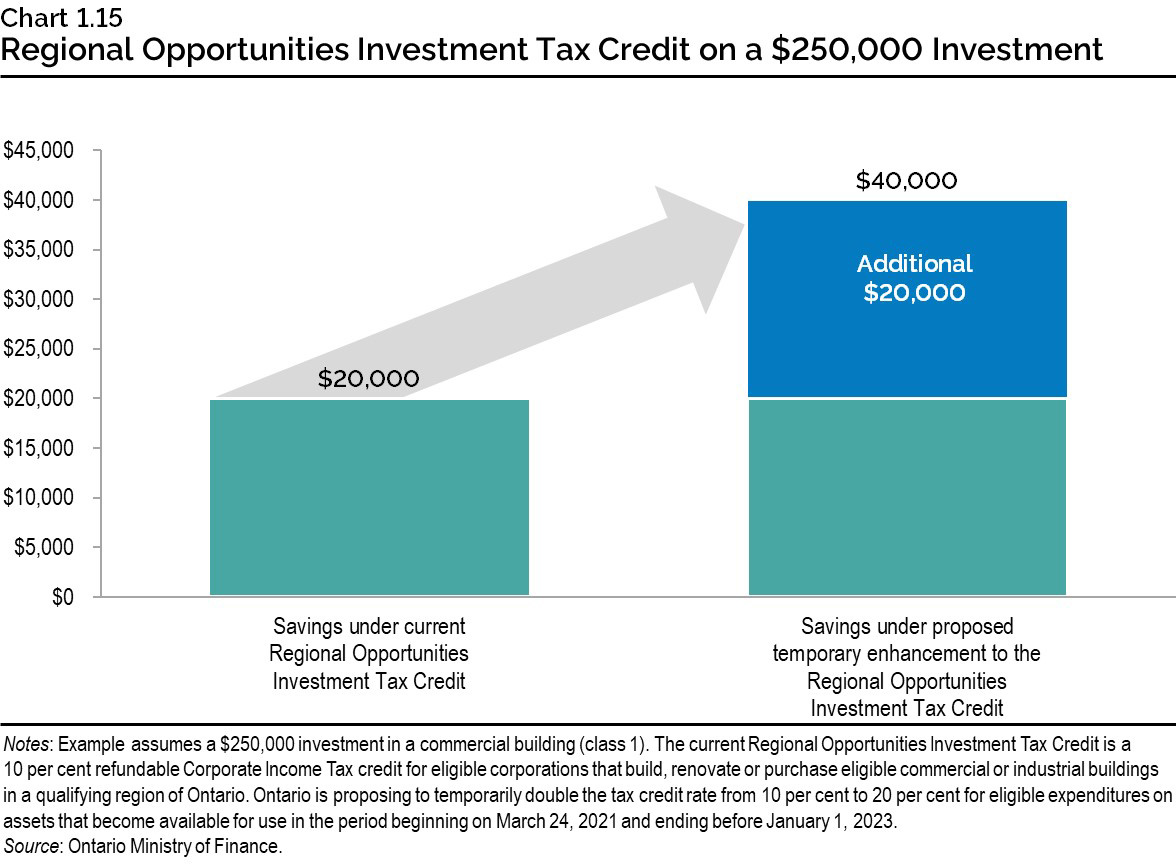
Making Key Infrastructure Investments
A key element of the government’s plan is investment in infrastructure, including strategic investments in transit, highways, schools, hospitals and broadband. Planned investments over the next 10 years total $145.4 billion, including $16.9 billion in 2021–22. These investments help stimulate job creation and economic growth and are vital to support COVID‑19 recovery efforts.
Accelerating Ontario’s Broadband and Cellular Action Plan
The COVID‑19 pandemic has highlighted the importance of broadband access for the people of Ontario to succeed in today’s increasingly digital economy. As many as 700,000 households in Ontario are underserved or unserved ― mostly in rural, remote or Northern areas. This has put businesses, students and vulnerable populations at a greater disadvantage during the pandemic. The Supporting Broadband and Infrastructure Expansion Act, 2021 would help accelerate timely deployment of reliable, high‑speed broadband infrastructure in unserved and underserved areas throughout Ontario. If passed, this legislation would remove barriers to help build better infrastructure faster, strengthen communities and boost the economy.
The 2021 Budget commits a historic new investment of $2.8 billion in broadband infrastructure to ensure that every region in the province has access to reliable broadband services by 2025. This proactive approach is the largest single investment in broadband, in any province, by any government in Canadian history and will be pivotal to Ontario’s long‑term economic growth. This sets the foundation for Ontario to be competitive for decades to come, and positions the province as a leader in the transformational shift to a digital economy where broadband connectivity is central to the future economic growth and development of Ontario.
This investment builds on Up to Speed: Ontario’s Broadband and Cellular Action Plan announced in 2019, to invest $315 million over five years to improve broadband connectivity in underserved and unserved communities, with a goal of increasing access for up to 220,000 households and businesses. This will generate up to $1 billion in total investment when combined with other public and private partner funding.
So the number one question that our members, the realtors, are getting in rural areas is, how’s the wireless? How is the internet communication? So I was really happy to see the investment in the last budget for expanding broadband access. I’d say keep down that path.
Tim Hudak
Chief Executive Officer
Ontario Real Estate Association
In November 2020, Ontario announced the next phase of its Up to Speed Plan, which included additional investments of over $680 million over the next four years. This funding provided an additional $150 million to double the Province’s commitment to the Improving Connectivity for Ontario (ICON) program.
Combined with these prior commitments, the new funding announced in the 2021 Budget increases Ontario’s overall investment in broadband to nearly $4 billion over six years beginning 2019–20. These initiatives seek to leverage funding from other levels of government including in some cases, the Canada Infrastructure Bank and the private sector. Other broadband funding available includes $1.7 billion provided nationally by the federal government through the Universal Broadband Fund.
Improving access to broadband and cellular services is a signature project of the Ontario Onwards Action Plan to digitize and modernize provincial services and programs. Connecting the people of Ontario to reliable broadband service will enable better access to information, media and services, and serves as a driver of economic growth and recovery. Broadband will play a key role in making vital government programs and services more convenient, reliable and accessible. Broadband supports economic productivity, health care, education and agriculture. Reliable access across all the regions of Ontario will allow the province to position itself as a leader in today’s global economy, and for decades to come.
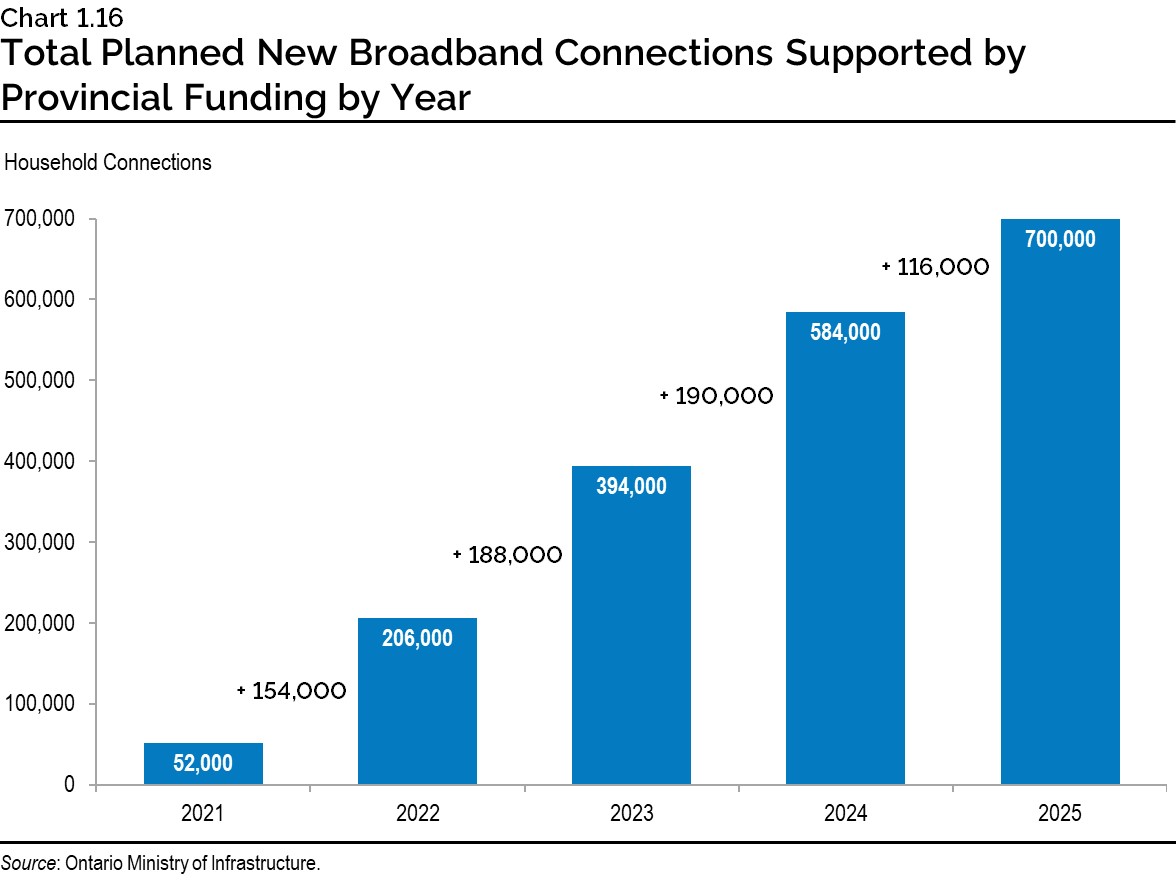
Demonstrating Progress on New Subway Projects

Major transit projects will stimulate future growth and job creation.
As announced in the 2019 Budget, the government’s new $28.5 billion subway transit plan for the GTA is the single largest investment in new subway builds and extensions in Canadian history. This includes the new Ontario Line, the three‑stop Scarborough Subway Extension, the Yonge North Subway Extension and the Eglinton Crosstown West Extension.
Ontario is working closely with its partners to deliver on these subway projects. In 2020, the Ontario government formalized partnership agreements with the City of Toronto and York Region that will ensure continued collaboration — working together effectively to successfully deliver the subway projects.
These projects will create thousands of jobs, provide more housing options for people and open up countless opportunities for businesses throughout the GTA and beyond. Ontario is a step closer to getting shovels in the ground:
- In December 2020, it issued two Requests for Proposals (RFPs) to design, build, finance, operate and maintain the Ontario Line. The contracts are expected to be awarded in 2022.
- In August 2020, it issued two RFPs to advance tunnelling work on the Scarborough Subway Extension and the predominantly underground Eglinton Crosstown West Extension projects. The contracts are expected to be awarded in 2021. Progress continues on early works including utility relocations.
- In March 2021, the Province released the Initial Business Case for the Yonge North Subway Extension. Ontario is leveraging previous planning, design and environmental assessment work completed to move this project forward as quickly as possible.
Ontario and its municipal partners continue to jointly call on the federal government to commit at least 40 per cent funding towards the priority subway projects and to contribute towards an updated Hamilton Light Rail Transit project.
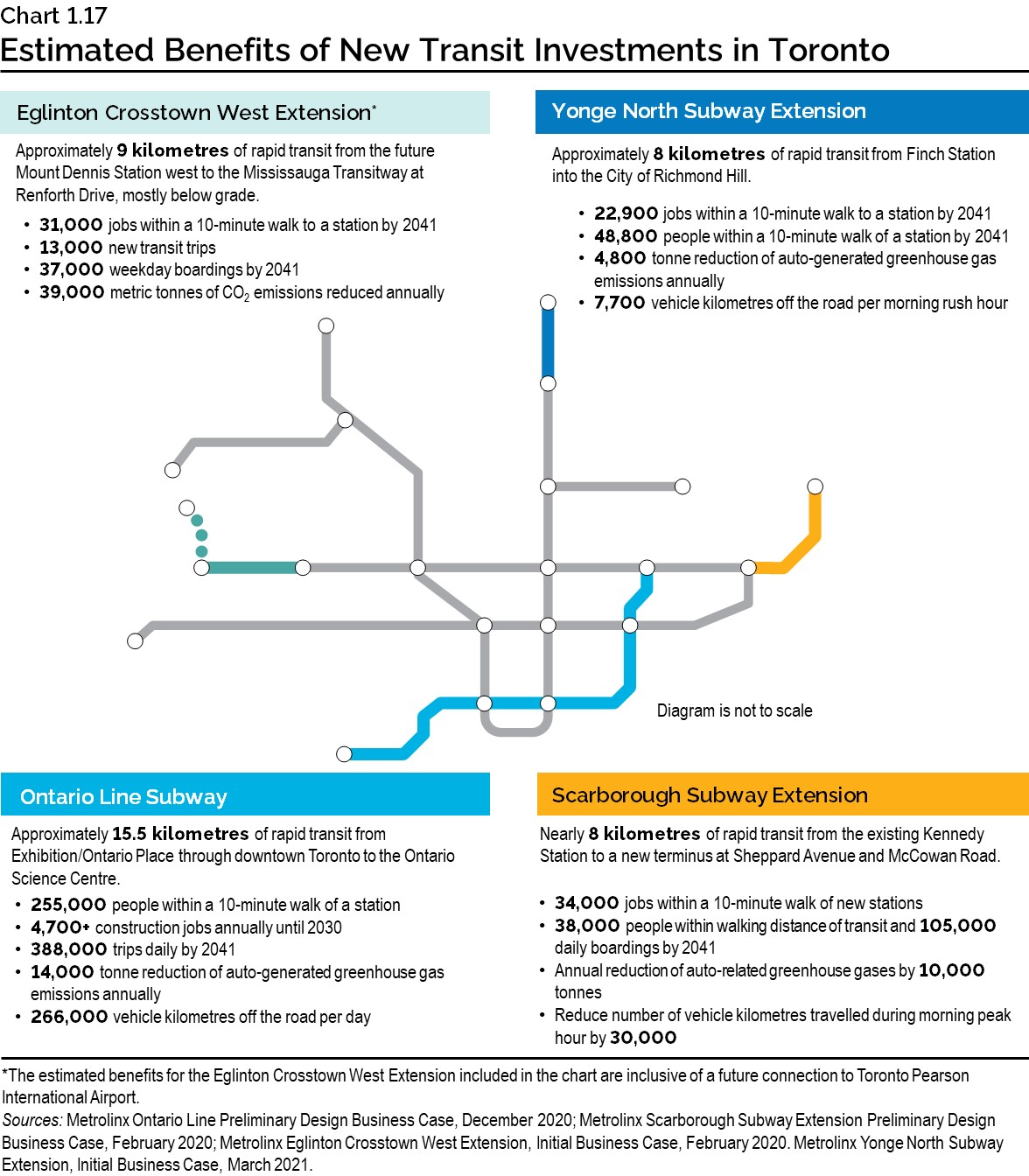
Improving and Expanding Service on the Kitchener GO Line
The Kitchener GO Rail Expansion project will provide mobility options, strengthen the connections between Waterloo Region and the Greater Golden Horseshoe and support economic development along the corridor.
Two-way, all-day service means more trains, at more times. It is delivering the service the region deserves. Ontario is one step closer to transforming the Kitchener GO line and increasing future capacity. In February 2021, the project reached 100 per cent excavation on the second tunnel as part of the Highway 401/409 tunnelling project to accommodate future additional tracks and future signaling and communications infrastructure.
As the next step, Ontario is investing in infrastructure works to enable service expansion along the corridor from Georgetown to Kitchener, including additional tracks and new platforms. Delivery along this corridor is expected to be staggered over three procurement phases, to include infrastructure improvements at key locations including Guelph Central Station, track maintenance and other track upgrades. Procurement work for phase one is underway and construction is estimated to begin in fall 2021. Procurement of subsequent phases is expected to take place between 2021 and 2023.
This project is expected to increase ridership, generate travel time savings and reduce automobile usage. It will also connect more people to jobs and improve passenger experience while increasing access to Ontario’s fastest growing urban areas along the Toronto-Waterloo Innovation Corridor and beyond. This supports Ontario’s goal of establishing a more reliable transit system in the Greater Golden Horseshoe, which will drive significant economic growth and job creation that will benefit the entire province.
Addressing Transportation Needs in the City of Hamilton
Ontario is keeping its commitment to provide $1 billion in capital funding to implement the Hamilton Transportation Task Force’s recommendation for a higher-order transit project and proceed with planning and design work for an updated light rail transit plan.
Ontario is calling on the federal government to partner on this important priority investment in transportation infrastructure for the City of Hamilton — with the objectives of improving access to the transportation network, reducing congestion and lowering greenhouse gas emissions.
Investing in Highways
A safe, modern and efficient transportation network is critical to keep people and goods moving, connect communities and boost local economies. Ontario’s smart investments in highway, road and bridge projects will stimulate future growth and job creation.
Ontario has allocated more than $21 billion in funding over the next 10 years, including about $2.6 billion in 2021–22, to expand and repair highways and bridges.
Continued investment in highway expansion projects across the province will connect communities, address safety concerns, alleviate congestion and support economic development. Several expansion projects are in planning and/or underway across all regions of the province, including:
- The widening of Highway 400, a critical tourism and goods movement link between Northern and Southern Ontario, as well as an important commuter route in the Toronto-Barrie corridor. Ontario will proceed with widening over 26 kilometres of the corridor between Langstaff Road and Highway 9 in York Region to 10 lanes, including the construction of approximately 22 kilometres of High Occupancy Vehicle (HOV) lanes. Widening of the first section — a 10-kilometre stretch between Major Mackenzie Drive and King Road, from six to eight lanes, is underway. All sections are expected to be completed by 2026–27.
- The expansion of Highways 6 and 401 between Hamilton and Guelph that will provide the needed capacity increase for Highway 401 and alleviate traffic congestion on Highway 6 — improving safety, traffic flow and network efficiency. Ontario will proceed with the next phase by constructing a new interchange for Wellington Road 34 on Highway 6 north of Highway 401 and relocating utilities. Early works are expected to begin in 2021.
- The Bradford Bypass, a new 16.2-kilometre four-lane controlled access freeway that will connect two busy Ontario highways — Highway 400 and Highway 404 — in the Town of Bradford West Gwillimbury and the Town of East Gwillimbury. Ontario is advancing engineering and environmental assessment work, which will allow early works to begin as early as fall 2021.
- The widening of Highway 6 South from Highway 403 to Upper James Street in the City of Hamilton, from two to four lanes for about nine kilometres. This stretch of highway is a significant trade corridor and a primary connection from John C. Munro Hamilton International Airport to the Greater Toronto and Hamilton Area via Highway 403.
- The Cochrane Bypass, a new three to six-kilometre two-lane highway that will connect Highway 652 to Highway 11 and provide access to Highways 574 and 579 in Northeastern Ontario. This project will improve safety and reduce travel times for families and truck drivers, while creating jobs in local communities in Northern Ontario.
- The widening of Highway 40 from Indian Road to north of Wellington Street in the City of Sarnia, from two to four lanes for approximately seven kilometres. This project will increase highway capacity, increase mobility, enhance highway safety and support growth in the Sarnia-Lambton bio-industrial area.
Supporting Passenger Rail in the North
Ontario is committed to reviewing initiatives to meet transportation needs in the North to optimize bus services and to develop options for passenger rail services across Northern Ontario. In keeping with the draft Transportation Plan for Northern Ontario, the government is accelerating work to examine safety and infrastructure needs for potential future passenger rail service between Toronto, North Bay, Timmins and Cochrane. Ontario is investing $5 million to support planning and design work. An initial business case is being finalized and is expected to be released in spring 2021.
Investing in the Canada Infrastructure Program
The Investing in Canada Infrastructure Program (ICIP) is a 10-year program that provides up to $30 billion in total funding, including $10.2 billion in provincial funding across the program’s five streams: Public Transit; Rural and Northern Communities Infrastructure; Green Infrastructure; Community, Culture and Recreation Infrastructure; and COVID‑19 Resilience. To date, Ontario has nominated over 760 projects to the federal government.
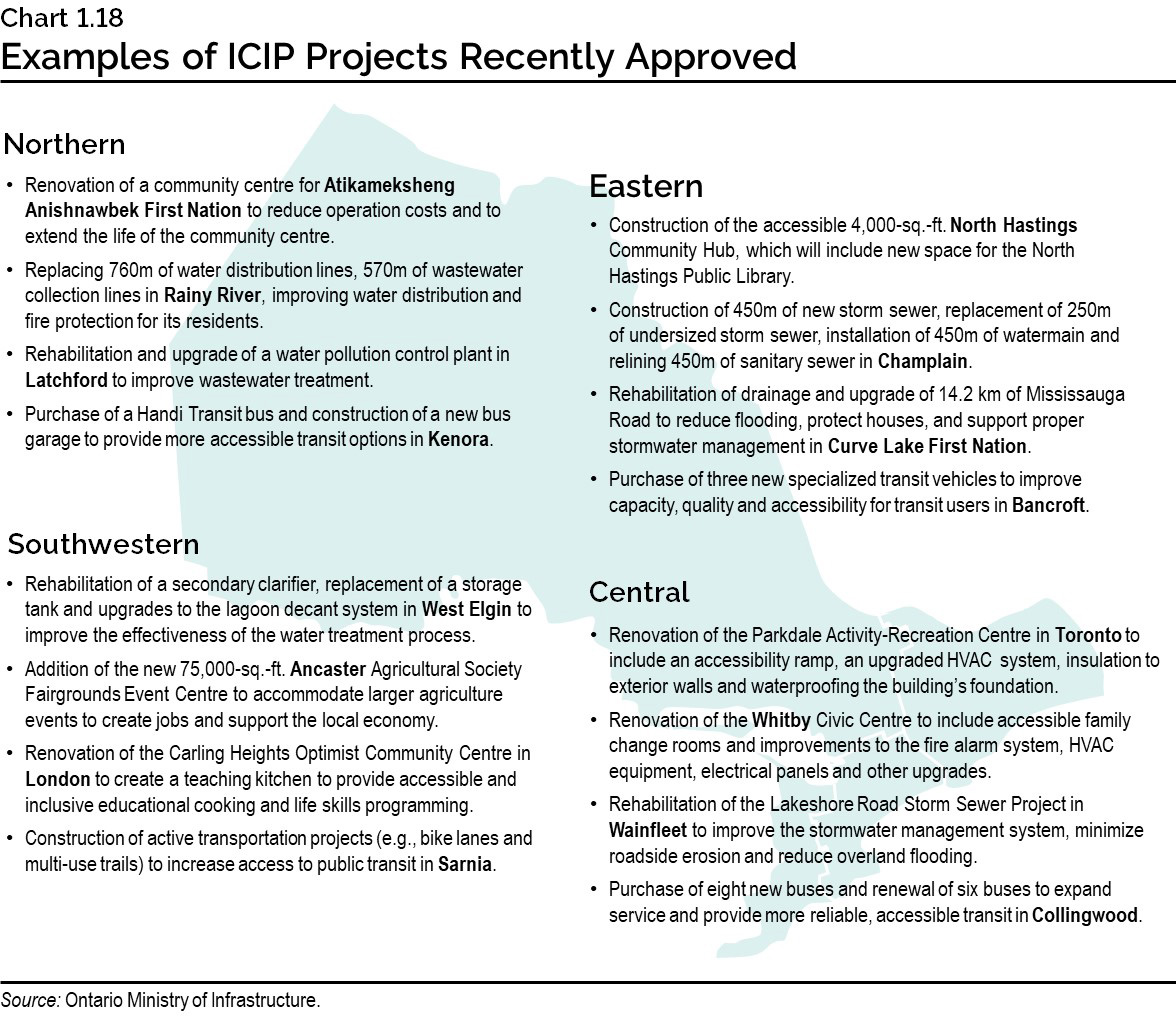
Investing in Local Infrastructure

Investing in infrastructure helps rural communities attract, support and sustain economic growth and job creation. On January 25, 2021 the Province announced a $200 million investment in municipalities through the 2021 Ontario Community Infrastructure Fund (OCIF) to help 424 communities build and repair roads, bridges, water and wastewater infrastructure. The OCIF provides funding for communities with populations of less than 100,000, as well as rural and Northern communities, to invest in local infrastructure and asset management planning to address their priority needs.
Ontario is building upon this investment by continuing to provide up to $200 million annually for OCIF to help eligible communities attract jobs and investment, as well as build local capacity to grow and thrive. This annual municipal investment provided through OCIF for local infrastructure in communities across Ontario will contribute to the province’s economic recovery and growth this year and in the years to come.
The Infrastructure Ontario (IO) Loan Program provides affordable, long-term financing to municipalities and other eligible public-sector partners across Ontario. Since inception, the IO Loan Program has helped support more than $18 billion in local infrastructure development and renewal. In 2020 the IO Loan Program committed to more than $550 million in loans, supporting 159 local infrastructure projects. The loan portfolio continues to grow and support community needs.
Positioning Key Sectors for Growth
Protecting and Creating Jobs in the Automotive Sector
The automotive sector directly employs over 100,000 people and supports thousands more throughout the supply chain and broader economy. In February 2019, the Province announced Driving Prosperity: The Future of Ontario’s Automotive Sector — the plan to ensure Ontario’s critical auto sector remains globally competitive and continues to grow and thrive. The plan, supported by three strategic pillars — a competitive business environment, innovation and talent — is helping to develop robust manufacturing supply chains for electric, autonomous and connected vehicles to support the long-term resiliency of the sector.
Ontario’s electric vehicle manufacturing capacity will play a vital role in securing future investments across the electric vehicle value chain. In October 2020, the government announced it is matching a $295 million investment with the federal government to retool the Ford Oakville Assembly Complex into a global hub for battery electric vehicle production. This $1.8 billion project represents one of the most significant investments in Ontario’s auto sector in a generation.
To maximize the impact of these investments across Ontario’s full automotive value chain, including a shift towards smart and clean technologies, Ontario is investing $56.4 million over the next four years to create the Ontario Vehicle Innovation Network (OVIN). The OVIN will build on successful elements of the Autonomous Vehicle Innovation Network (AVIN), accelerating the development of next generation electric, connected and autonomous vehicle and mobility technologies, as well as supporting Ontario’s role as the manufacturing hub of Canada.
The OVIN will also encourage innovation and collaboration through partnerships between small and medium-sized enterprises (SMEs), academia, the auto industry and battery sector, including critical minerals development in Ontario’s North. Ontario has a vast network of leading auto manufacturers and suppliers as well as a dynamic technology sector. The province is well positioned to continue to lead on electric and autonomous vehicle research and technologies.
Other proposed significant investments in the auto sector include the October 2020 announcement that Stellantis (previously Fiat Chrysler Automobiles), will invest up to $1.5 billion to support the assembly of plug-in hybrid vehicles and battery electric vehicles in the Windsor Assembly Plant. As well, General Motors will create Canada’s first large-scale commercial electric vehicle manufacturing plant at its Ingersoll facility, with an investment of $1 billion. Additionally, General Motors announced up to $1.3 billion to reopen the Oshawa Assembly Plant and to support added engine and transmission production in St. Catharines. The Oshawa Assembly plant will include a flexible assembly module and new body shop to support demand for pickup trucks.
Promoting Ontario Manufacturers
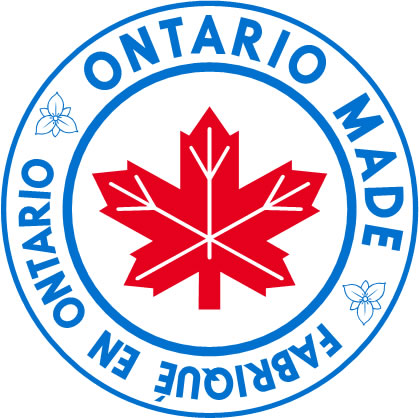
Last July, the Canadian Manufacturers and Exporters (CME) launched the Ontario Made program, with support from the Ontario government, to help promote Ontario’s manufacturing sector. The consumer awareness program encourages manufacturers and producers to register and promote their products on the SupportOntarioMade.ca site and use the Ontario Made logo to identify locally made items.
In its first year, the Ontario Made program has strengthened consumer awareness of goods manufactured in Ontario. To date, 2,000 large and small manufacturers have registered over 9,000 products with the CME to obtain the Ontario Made designation. The initiative has benefited both manufacturers and consumers during the COVID‑19 pandemic and will continue to do so in the post-pandemic recovery.
The partnership between CME and your government to promote our homegrown manufacturers through the Ontario Made program has had an outstanding start. In just five short months we have accomplished incredible milestones together and doubled original expectations.
Mathew Wilson
Senior Vice-President, Policy & Government Relations
Canadian Manufacturers & Exporters (CME)
Ontario is investing $1 million in 2021–22 to support enhancements to the Ontario Made program to reach more retailers and manufacturers, to encourage participation and build awareness and recognition among consumers of Ontario-made products. This includes increasing signage at retail stores, made-in-Ontario pavilions at fall fairs and community events when safe, and enhancing and leveraging digital marketing. The goal is to build a brand that Ontario consumers will seek out when shopping, while also improving awareness of the benefits of buying Ontario-made.
Protecting and Supporting the Agri-Food Sector
Ontario continues to provide support to the agri-food sector to protect the health and safety of workers during COVID‑19. The Province is investing $10 million in 2021–22 for a one-year extension to the Enhanced Agri-food Workplace Protection Program announced in June 2020. This will support the implementation of measures to prevent and control COVID‑19 and to address unforeseen worker health and safety issues.
Supporting Livestock and Processing Capacity
Pandemic-related challenges have resulted in disruptions in some meat processing facilities, impacting the food supply chain and causing livestock to back-up on farms. To help respond to this disruption, Ontario is investing up to $5 million in 2021–22 for a one-year extension for AgriRecovery initiatives, including those related to livestock processing capacity, such as beef and pork set aside programs.
Modernizing the Capital Markets Sector
In February 2020, Ontario appointed the Capital Markets Modernization Taskforce (Taskforce) to review the capital markets regulatory framework — which had not been reviewed in over 17 years. The need to modernize capital markets is imperative in order to remain competitive with global peers. The Taskforce’s final report was completed in December 2020 and publicly released in January 2021.
As the government continues to review the report, it is moving forward with legislative amendments to support the expansion of the Ontario Securities Commission’s (OSC) mandate to include competition and capital formation in order to facilitate economic growth. Ontario is also moving forward with proposed amendments to separate the OSC Chair and Chief Executive Officer position into two distinct roles, as well as to separate the currently combined board and adjudicative responsibilities of the Commission. These proposed changes will represent corporate governance best practices and instill more confidence in Ontario’s capital markets when they come into effect later this year.
In the coming months, the government will publish the draft Capital Markets Act for stakeholder consultation. Concurrently, the OSC is conducting analysis to inform its regulatory consultation process on the Taskforce’s recommendations that fall within the purview of OSC rules. These changes, consultations, and ensuing reforms over the coming year represent an overdue modernization of Ontario’s capital markets that will lead to future economic growth and job creation.
Generating, Protecting and Commercializing Intellectual Property
Intellectual property (IP) is an increasingly important contributor to growth and the intangible economy. Firms with IP assets such as patents, copyrights and trademarks often have higher rates of growth and are important job creators. Following the recommendations made by the Expert Panel on Intellectual Property, the government introduced Ontario’s first Intellectual Property Action Plan in July 2020.
Ontario is making a new $1.5 million investment to support the Special Implementation Team on Intellectual Property, which was established as a continuation of the work of the Expert Panel. This funding will help launch a web-based IP curriculum, support the development of a centralized Ontario resource and create a robust IP policy that will help protect home‑grown ideas and prioritize the commercialization of IP-related products to fuel Ontario’s innovation ecosystem.
Ontario is working with universities, colleges and research institutes to clarify the commercialization mandates of postsecondary institutions, in order to ensure that IP generated through taxpayer- funded research in the province’s world-class postsecondary sector results in social and economic benefits for the people of Ontario. There is also work underway to develop accessible, basic and advanced IP curricula that is web-based for researchers and businesses to enhance IP awareness and understanding.
Supporting Jobs and Growth in Northern Ontario
Supporting Junior Mining Exploration
The mining sector is an important driver of economic growth. The impact of COVID‑19 on the mining sector has resulted in a decrease in the availability of capital for mineral exploration. Junior mining companies rely on this capital to finance exploration. The success of junior exploration is critical to the discovery of existing and new mineral deposits that support larger mining companies, equipment manufacturers and investors across the province.
To support junior mining companies, Ontario is investing $5 million over the next two years in the new Ontario Junior Exploration Program. Through the program, junior mining companies can apply for funding to cover eligible costs of up to $200,000 per mineral exploration or development project. This program will attract investment, improve Ontario’s competitiveness in the exploration sector and help facilitate the discovery of promising mining opportunities.
Advancing Critical Minerals Development in Ontario
Ontario is strengthening its position as one of North America’s premier jurisdictions for responsibly sourced critical minerals, including rare earth elements. The province is developing Ontario’s first‑ever critical minerals strategy to support the mining industry, high-growth sectors, innovative clean technologies and the transition towards a low-carbon economy both at home and abroad.
Helping Northern Ontario’s Economic Recovery
Even before the COVID‑19 pandemic began, Northern Ontario’s economy had not yet fully recovered from the previous recession. The pandemic caused employment levels to decrease further while the unemployment rate increased in the Northern areas of the province.
To help businesses and communities, the Northern Ontario Heritage Fund Corporation (NOHFC) is changing to better serve the Northern economy. In September 2020, the government launched the short-term Northern Ontario Recovery Program (NORP), through the NOHFC, to respond to the challenges of the COVID‑19 pandemic. This $20 million program has aided in the recovery from COVID‑19 by helping Northern companies adapt their operations to meet new public health guidelines, protect employees and customers and rebuild consumer confidence.
In February 2021, the government announced an improved NOHFC program with a focus on culture, talent, business development and community infrastructure. Alongside these program changes, an additional $50 million over the next two years will be allocated to the NOHFC to support investments in infrastructure, culture, economic development and training. These new programs will help increase economic development and promote job creation in all regions of the North.
Protecting Ontario’s Environment
Ontario is acting to protect the environment and fight climate change for people today and in the future through a broad range of measures that will lead to healthier communities and support economic growth by protecting Ontario’s air, land and water.
Advancing Ontario’s Clean Energy Advantage
Ontario continues to be a leader in clean energy. In 2019, approximately 94 per cent of Ontario’s electricity supply was produced from zero carbon emitting sources, including 58 per cent from nuclear and 24 per cent from hydro. Investors are increasingly concerned about environmental, social and governance issues, and manufacturers in Ontario are using clean electricity while competing with businesses in Michigan, Ohio and Tennessee that are still significantly powered by coal-fired electricity generation. Ontario’s clean electricity supply, at a competitive price, can provide the province with an advantage in attracting investment. The government’s comprehensive electricity plan, announced in the 2020 Budget, is working to ensure that Ontario’s job creators receive wind, solar and bioenergy generated electricity at a competitive price.
Leading the Way in the Canadian Green Bond Market
Ontario’s Green Bonds capitalize on the Province’s ability to raise funds at low interest rates and serve as an important tool to help finance public transit initiatives, extreme weather resistant infrastructure and energy efficiency and conservation projects.
Ontario is currently the largest issuer of Canadian dollar Green Bonds, with nine issues totalling $8 billion. A total of 27 projects have received, or will receive, funding from Ontario’s nine Green Bond issues. See Chapter 4: Borrowing and Debt Management for more details.
Increasing the Use of Environment, Social and Corporate Governance Disclosure Requirements
Last year, the government appointed a Capital Markets Modernization Taskforce to review and make recommendations in relation to modernizing the capital markets regulatory framework. Throughout the Taskforce’s public consultations, the increased use of environment, social and governance (ESG) disclosure received significant support from industry stakeholders. In its final report, the Taskforce recommended mandating disclosure by public companies of material ESG information, specifically climate-related disclosure that is compliant with the Task Force on Climate‑Related Financial Disclosure recommendations. The Ontario Securities Commission will begin policy work to inform further regulatory consultation on ESG disclosure later this year.
Leading in Electric Vehicle Development
Recent proposed investments in Ontario’s auto sector will make the province a global hub for Electric vehicle (EV) manufacturing. Electric vehicle technology presents a major opportunity to decrease greenhouse gas emissions. With world-class tech startups, manufacturing plants and critical mineral resources, Ontario is uniquely positioned to lead the development of next generation electric, connected and autonomous vehicle and mobility technologies.
See the Protecting and Creating Jobs in the Automotive Sector section earlier in this chapter for more details.
Creating the Ontario Vehicle Innovation Network
Ontario is investing $56.4 million over the next four years to create the new Ontario Vehicle Innovation Network. This will help accelerate the development of the next generation electric, connected and autonomous vehicle and mobility technologies that contribute to a lower environmental and carbon footprint.
See the Protecting and Creating Jobs in the Automotive Sector section earlier in this chapter for more details.
Developing Ontario’s First-Ever Critical Minerals Strategy
Ontario is developing its first-ever critical minerals strategy to help strengthen its position as one of North America’s premier jurisdictions for responsibly sourced critical minerals, including rare earth elements. Rare earth and battery minerals are needed for new technologies and high‑growth sectors, like renewable energy, electronics, electric vehicles and clean tech to support a low-carbon future.
See the Advancing Critical Minerals Development in Ontario section earlier in this chapter for more details.
Growing the Greenbelt
The Greenbelt is a large area of permanently protected land that currently includes over 800,000 hectares in the Greater Golden Horseshoe. The Greenbelt helps build resilience to and mitigates climate change, while protecting Ontario’s environmental, groundwater and agricultural resources for future generations. It is also home to much of Ontario’s vital environmental, groundwater and agricultural resources.
For future generations, the government has been clear that it is protecting the Greenbelt from development. This is why the 2020 Budget committed to expand the size of the Greenbelt. As another step to achieving this commitment, the government launched a 60-day consultation in February 2021 on growing the Greenbelt.
The consultation is seeking feedback on the proposal to add the Paris-Galt Moraine into the Greenbelt, as well as expand, add and further protect Urban River Valleys into high-density urban environments. The government’s consultations could lead to the largest expansion of the Greenbelt since its creation in 2005.
To build upon Ontario’s commitment, the government is exploring the enhancement of the Greenbelt through the creation of the East Humber Headwaters Park on the Oak Ridges Moraine. A new park could provide an uninterrupted link between the eastern and western ends of the moraine and includes the headwaters of the East Humber River. This would support the restoration of the over 500-acre vacant site to its natural state.
This historic expansion and protection — one of the largest near urban parks in the country — would position the Township of King and the entire province as a leader in conservation and as a steward of Ontario’s natural heritage.
Protecting Communities from Flooding
Ontario is helping to ensure that the public is better prepared for flooding events and that flood risk is reduced for communities across the province. To help implement Protecting People and Property: Ontario’s Flooding Strategy, the government is moving forward with a range of activities, such as improving floodplain mapping guidance and establishing a flood-mapping technical team to better identify hazard areas. The Province is also providing ongoing support for municipalities through the Ontario Community Infrastructure Fund, which helps small, rural and Northern communities invest in local infrastructure and asset management planning to address their priority needs, including flood protection and climate adaptation.
Supporting Communities
By connecting friends, family, neighbourhoods and cities, Ontario’s diverse communities play important roles in the lives of people and the province’s economic recovery. The government is making important investments to ensure that communities across the province remain strong and have the support they need to get through this challenging period and beyond.
Doubling the Indigenous Community Capital Grants Program
Ontario is committing to doubling investments in the Indigenous Community Capital Grants Program, which will help address long-term infrastructure needs and fast-track shovel-ready on- and off-reserve projects.
As part of this investment, Ontario will provide $6 million annually to fund upgrades to critical infrastructure, address COVID‑19 specific capital needs and support long-term economic recovery in Indigenous communities. Upgrades under the program could include improvements to ventilation systems or airflow in communal spaces, along with the construction of community infrastructure such as business and training centres.
Supporting Ontario’s Francophone Communities
To support Ontario’s Francophone communities through COVID‑19, Ontario is building on its initial investment of $2 million in the COVID‑19 Relief Fund for Francophone Non-Profit Organizations by providing an additional $1 million to support hard hit Francophone non-profit organizations.
This funding will continue to support organizations with operating costs, including preventing closures and retaining and recruiting skilled bilingual staff. The fund is crucial to ensuring that the network of Francophone non-profit organizations can continue their important contribution to the vitality of Ontario’s Francophone community.
The government is committed to the long-term economic recovery and development of Francophone communities across Ontario. This is why Ontario is investing $3 million over three years to better meet the increased need and demand for support from community organizations, including social enterprise and small businesses, serving Ontario’s Francophone community across all regions of the province. This investment will continue to support the cultural and economic vitality of Ontario’s Francophone communities. These community organizations and businesses contribute significantly to Ontario’s Francophone community and provide a range of essential services throughout the province.
Ontario is also supporting a long-term Francophone economic development strategy, which includes sustaining the Francophone Business Network and expanding the range of business support services through the creation of a Francophone business incubator. The incubator will support new startups and help promote Franco-Ontarian goods and services across the province. This initiative is part of a broader strategy to address the challenges arising from COVID‑19 and to reflect the shift towards economic recovery.
Finally, Ontario is committed to maintaining its close relationship with its provincial partners, including Québec. To do this, the government is dedicating $250,000 annually for the next three years to support interprovincial projects led by Franco-Ontarian organizations, as part of the Ontario-Québec Cooperation and Exchange Agreement.
Addressing the Unique Challenges of COVID‑19 on Women
While everyone has been affected by COVID‑19, some people have been more affected than others. Just as seniors are at greater risk of negative health outcomes due to COVID‑19, some in our communities have ended up paying a higher price than others as a result of public health restrictions and systemic inequities.
This is unfair. And the government’s support is designed to ease the burden for those who have been carrying more of the load during this difficult year.
Women, in particular, have been disproportionately affected. The statistics are indisputable. For example, while employment among men has dropped by 3.3 per cent during COVID‑19, it is down by nearly five per cent for women.
This is partly because women are disproportionately represented in the jobs that have been most affected by the necessary public health restrictions.
The challenges have been made worse by the high cost and lack of access to child care spaces. While this impacts all parents, mothers in particular, end up paying a high price.
Finally, as noted earlier in this chapter, the spike in domestic violence has largely impacted women.
This is why Ontario is taking action to support affected workers and small business owners, improve access and affordability for child care, and support survivors of violence against women. These actions include:
- Dedicating $117.3 million in targeted employment and training supports to assist women, racialized individuals, Indigenous peoples, youth and people with disabilities who are facing the highest rates of unemployment during the pandemic. This funding will help remove barriers and offer training opportunities so they can get the in-demand skills they need for good jobs, and get connected with employers looking to grow their businesses.
- Supporting women entrepreneurs and business owners through programs such as the Digital Main Street program and the Ontario Small Business Support Grant.
- Continuing to provide choice of access to safe, high quality and affordable child care over the course of the pandemic, including flexible funding approaches and health and safety supports to help keep child care programs open.
- Committing to create up to 30,000 new child care spaces, including up to 10,000 spaces in new schools. As of winter 2021, over 20,000 new spaces have been approved, which will support families and ensure a strong and accessible system.
- Proposing to enhance the Childcare Access and Relief from Expenses (CARE) tax credit, which helps Ontario families with child care costs while letting them choose the care that is right for their children.
While these important measures will provide support and relief, much more will be required to ensure women will not be left behind after COVID‑19.
To advise the government on this vital work, Ontario’s Minister of Finance and the Associate Minister of Children and Women’s Issues will establish a task force to ensure inclusive economic growth is achieved. The mandate of this group will seek to address the unique and disproportionate economic barriers women face, particularly in an economy that will look different after COVID‑19. The work will be informed by diverse voices from the public, private and not-for-profit sectors.
Helping Faith-Based and Cultural Organizations Reopen
The government recognizes that many faith-based and cultural organizations that operate facilities for regular community gatherings are facing additional costs to meet public health guidelines as they safely reopen their facilities.
To provide meaningful support and help offset costs associated with making these facilities safe for regular community gatherings, the government will be making up to $50 million available for grants to eligible faith-based and cultural organizations that are not currently eligible to access other provincial support grants. To be eligible, organizations must operate facilities used for regular community gatherings and must not be eligible for the Ontario Small Business Support Grant. Details on the grant and the application process will be available later this spring.
Delivering Historic Funding for All Municipalities
COVID‑19 has placed a significant strain on municipalities. Ontario has been working with all levels of government to ensure that municipalities have the support, flexibility and tools they need to address the critical public health and economic challenges brought on by the pandemic.
Through the historic federal–provincial Safe Restart Agreement, $4 billion in assistance has been allocated to all 444 municipalities and up to 110 public transit systems across the province. This funding was provided so every Ontario municipality could address their operating pressures, support reliable service levels for transit systems and help vulnerable people while ensuring that essential workers could get back to work.
Ontario remains committed to assisting municipalities in their efforts to address the continued challenges of the pandemic and to support a safe and strong recovery. This is why Ontario is providing municipalities with almost $1 billion in additional COVID‑19 financial relief, including:
- $500 million in additional provincial funding to support municipal operating pressures and recovery in 2021;
- $255 million in new provincial funding through the Social Services Relief Fund to support municipal service managers and Indigenous program administrators in immediately responding to rising COVID‑19 caseloads in shelter settings. This builds on the $510 million provided through the Social Services Relief Fund in 2020–21 that ensured the continuity of critical supports for vulnerable people based on local need; and
- $150 million in additional provincial funding to support municipal transit systems in 2021, including expanded eligibility for municipal–provincial priorities such as fare and service integration and on-demand microtransit.
This additional $500 million for 2021 builds on a record of provincial government support…. It will help offset the impact of COVID‑19 on 2021 municipal budgets in every part of Ontario. By protecting the municipal services people and business rely on most, and preventing delays in capital projects, this funding is an important investment in Ontario’s economic recovery.
Graydon Smith
President
Association of Municipalities of Ontario
Through these investments Ontario is taking immediate and decisive actions to support municipalities. Assisting communities through these extraordinary times requires the support of all levels of government. Ontario will continue to work closely and collaboratively with its partners, including the federal government and all municipalities, to ensure that communities across the province have the resources they need to deliver critical public services, keep capital investments on track and support a strong economic recovery.
Working with Municipalities to Review the Ontario Municipal Partnership Fund
The government is reviewing the Ontario Municipal Partnership Fund in consultation with municipalities, to ensure the program meets the needs of local communities, particularly small, Northern and rural municipalities. Discussions with municipal partners will continue, understanding that stability remains an important priority for municipalities.
Providing Property Tax Stability
The government has been conducting a Property Assessment and Taxation Review to explore opportunities to:
- Enhance the accuracy and stability of property assessments;
- Support a competitive business environment; and
- Strengthen the governance and accountability of the Municipal Property Assessment Corporation (MPAC).
Input is being sought from municipalities, taxpayers, industry associations and other interested stakeholders.
As announced in the March 2020 Economic and Fiscal Update, the government postponed the property tax reassessment that was scheduled to be conducted in 2020 for the 2021 taxation year to maintain stability in the context of the emerging pandemic.
To provide continued stability, Ontario is implementing a further postponement of the property tax reassessment. This will provide certainty for businesses and residents, and it will enable municipalities to focus their attention on responding to the challenges posed by COVID‑19.
This delay will not have a financial impact on municipalities, as MPAC will continue to maintain the assessment roll and ensure that it is updated to reflect changes such as new construction.
Through the Property Assessment and Taxation Review, the government will be seeking input from municipalities, taxpayers and interested stakeholders regarding the timing and valuation date for the next reassessment. The outcomes from this consultation will be communicated in fall 2021.
Building a Modern Government
The world has changed, and government must change with it. This is why, over the past year, Ontario has moved quickly to adapt and update programs and services to help the people of Ontario deal with the challenges created by the COVID‑19 pandemic. Not only does modernization help save taxpayers’ money and make people’s interactions with government more convenient, it will also support Ontario’s economic recovery and enable a modern digital economy.
Progress on Ontario’s COVID‑19 Action Plan for a People-Focused Government
In October 2020, the government announced Ontario Onwards: Ontario’s COVID‑19 Action Plan for a People-Focused Government. The Action Plan is a roadmap organized under four categories that will change the way people and businesses interact with government, both in terms of its services and how it delivers them. The four categories are:
1. Making government services more digitally accessible, with the goal of making Ontario the most advanced digital jurisdiction in the world.
To support this objective, the Province will introduce a new form of secure, electronic government-issued ID that can be used to conveniently access government services while protecting data privacy.
By using this innovative technology, parents could more easily access their children’s immunization records and share them digitally with their school. Seniors could check in to doctors’ appointments online and securely share health information with caregivers and health care providers. Through this technology, users will be in full control of what personal information is shared and with whom. Those who choose not to have a digital ID will still be able to prove their identity and access services using physical documents.
2. Reducing red tape and simplifying policies to make life easier for the businesses of Ontario while protecting public health and safety.
Ontario will improve businesses’ interactions with government by providing opportunities for immediate feedback, automating and digitizing government operations for 24/7 responsiveness, and delivering customer-focused services by expediting self-registration and self-reporting. This allows people and business to invest time and money to focus on what’s important right now — recovering and emerging from this pandemic. Continuing to improve Ontario’s regulatory framework is key to making Ontario work better for people and smarter for business in this recovery period and beyond.
3. Improving government purchasing by leveraging the combined buying power of the province while taking advantage of the innovation and creativity of local Ontario businesses.
A new procurement agency, Supply Ontario, will enable the government to purchase as one organization, ensure the supply chain is secure and quality supplies are available throughout the province, as well as drive innovation and emerging technologies.
In the context of the COVID‑19 pandemic, the new agency will also help ensure that the government continues to keep the people of Ontario safe by making it easier to source PPE and other critical supplies and equipment across multiple organizations, and create opportunities for businesses in all regions to supply our province.
4. Creating more responsive and flexible public services to make government processes faster and more efficient.
Ontario is applying Lean and continuous improvement principles across programs to make frontline services more efficient, convenient, reliable and accessible for citizens and businesses. For example, a record number of applications to the Ontario Immigrant Nominee Program were processed to help reunite families, and support highly qualified future residents who wish to come to this great province.
Supporting Innovative Solutions through the Ontario Onwards Acceleration Fund
To improve how people and businesses experience services in Ontario, the 2020 Budget announced an investment of $500 million through the Ontario Onwards Acceleration Fund. This fund is a vital step in achieving the vision of an Ontario that is the most digitally advanced jurisdiction in the world. The government’s investments in projects that emphasize digital-first and Lean methods will ensure a more customer-focused, efficient and effective delivery of services.
This fund is already supporting several innovative initiatives, which include:
- $28.5 million over four years to implement a new case management system for Tribunals Ontario, which will replace obsolete legacy systems. Once implemented, the new system will modernize client interactions, provide comprehensive online dispute resolution services, and enhance parties’ ability to monitor cases online and receive/submit documents electronically.
- $7 million over three years to support continuous improvements in online health claims processes and to implement business intelligence software to identify fraud and provide visual data analytics reports. Investments will improve the user experience and service delivery for physicians and other providers submitting claims through the OHIP claims system.
- $10.6 million over two years to accelerate the Ontario Ministry of Natural Resources and Forestry’s transition from paper-based applications for licences and permits to digital and online formats.
- $2.2 million to initiate the development of the Single Window for Business, a transformational digital solution designed to use emerging technology, data, and responsive design to improve business experience with government services. A designated single window will reduce administrative burdens and improve the customer experience, by providing a single place that makes it easier for businesses to access the information and services they need to get up-and-running, create jobs and grow.
Moving Ahead on iGaming
Ontario is moving ahead with the development of a new, legal internet gaming (iGaming) market which will provide stronger consumer protection and combat illicit gaming market activity. To support the process, the government appointed a Commercial Project Lead for iGaming. Ontario is currently accepting feedback on the design of the framework . A discussion paper can be found at Ontario.ca/iGaming.
Reviewing the Pension Benefits Guarantee Fund
In the 2020 Budget, Ontario announced that it would conduct a review of the Pension Benefits Guarantee Fund (PBGF) and report back in the 2021 Budget.
Today, the PBGF is in a strong financial position. However, the number of plans covered by the PBGF is decreasing as defined benefit plans continue to close. At the same time, conversions to the jointly sponsored pension plan model, while providing benefits such as shared governance and efficiencies, also decrease the number of covered plans. The declining number of plans paying into the PBGF further concentrates risk among fewer employers.
The review of the PBGF found that there is a need for data to better estimate the PBGF’s exposure to future claims and the appropriate level of funding by employer sponsors. To address this, Ontario will amend Regulation 909 under the Pension Benefits Act to require pension plan administrators to calculate and report their plan’s PBGF claim exposure. Ontario will use the improved data to support the protection of pension benefits into the future.
Footnotes
[1] Based on Statistics Canada Labour Force Survey data for the Accommodation and Food Services and Information, Culture and Recreation sectors.
Chart Descriptions
Chart 1.6: Additional Child Care Support in 2021
This chart shows the average support provided, as a percentage of eligible child care expenses, by federal and provincial Personal Income Tax relief through the Child Care Expenses Deduction, the current Ontario CARE tax credit, and the proposed temporary CARE tax credit top-up (2021).
The chart shows that the average federal and Ontario tax relief provided by the deduction (bottom grey area) is of relatively little benefit to lower-income families, and that relief increases with family income as a percentage of eligible child care expenses. The chart also shows the additional support that the current Ontario CARE tax credit in the middle light green area, and the proposed temporary CARE tax credit top-up, in the upper dark blue area, would provide, bringing the average overall relief up to about 90 per cent of eligible child care expenses for families with incomes of up to around $50,000. After this point, the overall support provided by the CARE tax credit, the proposed CARE tax credit top-up and the tax relief provided by the deduction decreases until family income reaches $150,000. If family income exceeds $150,000, the tax credit is zero (as would be the top-up) and families could only benefit from the tax relief provided by the deduction.
Note: Each component represents 2021 estimates of average amounts as a percentage of eligible child care expenses.
Source: Ontario Ministry of Finance.
Chart 1.7: Additional Child Care Support for Families in 2021
This bar chart shows the existing and enhanced support three representative families would get in 2021.The proposed temporary Ontario CARE tax credit top-up is shown on top of the current Ontario CARE tax credit and federal and Ontario Personal Income Tax relief these families receive from the existing Child Care Expenses Deduction.
Left section: Mirjana is a single parent with an eight-year-old child. With annual earnings of $40,000, and eligible child care expenses of $1,000 for the year, she would get $250 in total federal and provincial Personal Income Tax relief from the deduction, $590 from the Ontario CARE tax credit, and an additional $120 from the proposed temporary CARE tax credit top-up. In total, this would bring total support to 96 per cent of eligible expenses.
Middle section: Chris and Sophie are a couple with a two-year-old child, and annual earnings of $45,000 and $50,000, respectively. With eligible child care expenses of $8,000, they would get $1,705 in total federal and provincial Personal Income Tax relief from the deduction, $2,480 from the Ontario CARE tax credit, and an additional $495 from the proposed temporary CARE tax credit top-up. In total, this would bring total support to 59 per cent of eligible expenses.
Right section: Alex and Robin are a couple with two children ages six and nine. With annual earnings of $55,000 and $70,000 respectively, and eligible child care expenses of $13,000, they would get $3,465 in total federal and provincial Personal Income Tax relief from the deduction, $1,950 from the Ontario CARE tax credit, and an additional $390 from the proposed temporary CARE tax credit top-up. In total, this would bring total support to 45 per cent of eligible expenses.
Note: Does not include payments from the Ontario COVID‑19 Child Benefit. Tax relief from the Child Care Expenses Deduction is for 2021 and, for Ontario Personal Income Tax, includes relief from the Ontario Health Premium.
Source: Ontario Ministry of Finance.
Chart 1.8: Ontario Jobs Training Tax Credit
The bar chart shows two examples of savings in 2021 due to the supports from the Canada training credit and the proposed Ontario Jobs Training Tax Credit. In the first example, Roz is 32 years old, working in a low-wage job. She has $700 in eligible expenses in 2021 for a course that will improve her skills and increase her chances of promotion. Out of the $700 of expenses, Roz receives $350 back through the Canada training credit, and $350 from the proposed Ontario Jobs Training Tax Credit. In total, Roz would receive $700 in support from training credits, or 100 per cent of her eligible expenses. This example assumes that Roz has a Canada training credit limit for 2021 of at least $350.
In the second example, Hope is 27 years old and lost her job due to the COVID‑19 pandemic. She has $4,050 in eligible expenses in 2021 for a training program for a new career. Out of the $4,050 of expenses, Hope receives $500 back through the Canada training credit, and $2,000 from the proposed Ontario Jobs Training Tax Credit. In total, Hope would receive $2,500 in support from training credits, or 62 per cent of her eligible expenses. This example assumes that Hope has a Canada training credit limit for 2021 of $500.
Source: Ontario Ministry of Finance.
Chart 1.9: Examples of School Projects Underway
This map shows examples of school projects that are underway across different regions in Ontario.
Northern: A new JK-12 school in Parry Sound that will include a child care centre with 49 licensed child care spaces and an EarlyON child and family centre. The Tarentorus Public School in Sault Ste. Marie will serve 92 elementary students and include a child care centre with 49 licensed child care spaces. A new joint public school between the English language and the French language school boards in Blind River will serve 453 elementary and secondary students and include a child care centre with 64 licensed child care spaces and an EarlyON child and family centre.
Eastern: The new English public 7-12 school in Ottawa will serve 1,516 students and include a child care centre with 39 licensed child care spaces. The new English Catholic elementary school in Ottawa will serve 507 students and include a child care centre with 39 licensed child care spaces. The new French public elementary school in Nepean will serve 256 students. The new English Catholic elementary school in Amherstview will serve 449 students and include a child care centre with 49 licensed child care spaces.
Central: The new English Catholic secondary school in Etobicoke will serve 1,300 students. The new English public elementary school in Brampton will serve 850 students and include a child care centre with 73 licensed child care spaces. The new English public elementary school in Whitchurch-Stouffville will serve 638 students. The new French public elementary school in North York will serve 412 students and will include a child care centre with 73 licensed child care spaces.
Southwestern: The new English public elementary school in Brantford will serve 650 elementary students and include a child care centre with 64 licensed child care spaces. The new English public 7-12 school in Kincardine will serve 881 elementary and secondary students. The Peace Bridge Public School addition in Fort Erie will serve 230 elementary students. The St. Mary Catholic School addition in Owen Sound will serve 702 elementary and secondary students.
Source: Ontario Ministry of Education
Chart 1.10: Illustrative Relief for a Small Retail Store
Illustrative relief for a small retail store in Markham which experiences a 70 per cent revenue loss due to COVID‑19 public health restrictions. The following measures would provide the retail store $59,325 in relief through the following measures for the first three months of 2021: Canada Emergency Rent Subsidy (federal) ($12,605), Canada Emergency Wage Subsidy (federal) ($4,090), Property Tax and Energy Cost Rebate Grants ($1,630), Ontario's Main Street Relief Grant: PPE Support ($1,000), Ontario Small Business Support Grant – Payment One ($20,000), and Ontario Small Business Support Grant – Payment Two ($20,000).
This business and its employees may be eligible for other supports (federal): Canada Emergency Business Account, Canada Recovery Sickness Benefit, and Highly Affected Sectors Credit Availability Program.
The small retail store has the current profile during COVID‑19: Has two employees, monthly revenue of $8,700, monthly payroll of $2,000, pays $5,000 in monthly rent and $8,300 in other monthly expenses.
Relief amounts do not take into account potential income tax implications.
Other monthly expenses include property tax, electricity, natural gas, and other monthly costs.
Maximum federal base subsidy of 65 per cent of rent costs for three four-week periods ending March 13, 2021, plus an additional top-up of 25 per cent in federal lockdown support for 64 days. This business has not applied for property tax and energy costs as part of its application.
Maximum federal subsidy of 75 per cent of eligible wage costs, with a 40 per cent base subsidy rate, plus a top up of 35 per cent for three four-week periods ending March 13, 2021.
Rebates equivalent to 100 per cent of its energy costs for two months and property taxes for 52 days. The energy portion for the illustrative business in this example is assumed to consume 520 kilowatt-hours per month of electricity and includes relief from off-peak electricity pricing from January 1, 2021 to February 22, 2021, and 385 cubic metres of natural gas
Purchases of at least $1,000 in eligible PPE.
Actual payment dates for the Ontario Small Business Support Grant may vary.
Note: While the example does not represent an actual company, the financial and employment profile is based on tax administration and Statistics Canada survey data for businesses in the industry.
Source: Ontario Ministry of Finance.
Chart 1.11: Illustrative Relief for a Restaurant
Illustrative relief for a restaurant in Toronto which experiences an 80 per cent revenue loss due to COVID‑19 public health restrictions. The following measures would provide the restaurant $141,510 in relief through the following measures for the first three months of 2021: Canada Emergency Rent Subsidy (federal) ($35,100), Canada Emergency Wage Subsidy (federal) ($49,290), Property Tax and Energy Cost Rebate Grants ($16,120), Ontario's Main Street Relief Grant; PPE Support ($1,000), Ontario Small Business Support Grant – Payment One ($20,000), and Ontario Small Business Support Grant – Payment Two ($20,000).
This business and its employees may be eligible for other supports (federal): Canada Emergency Business Account, Canada Recovery Sickness Benefit, and Highly Affected Sectors Credit Availability Program.
The restaurant has the current profile during COVID‑19: Has 13 employees, monthly revenue of $38,100, monthly payroll of $23,700, pays $13,000 in monthly rent and $45,900 in other monthly expenses.
Relief amounts do not take into account potential income tax implications.
Other monthly expenses include property tax, electricity, natural gas, and other monthly costs.
Maximum federal base subsidy of 65 per cent of rent costs for three four-week periods ending March 13, 2021, plus an additional top-up of 25 per cent in federal lockdown support for 84 days.This business has not applied for property tax and energy costs as part of its application
Maximum federal subsidy of 75 per cent of eligible wage costs, with a 40 per cent base subsidy rate, plus a top up of 35 per cent for three four-week periods ending March 13, 2021.
Rebates equivalent to 100 per cent of its property taxes and energy costs for three months. The energy portion for the illustrative business in this example is assumed to consume 18,500 kilowatt-hours per month of electricity and includes relief from off-peak electricity pricing from January 1, 2021 to February 22, 2021, and 2,160 cubic metres of natural gas.
Purchases of at least $1,000 in eligible PPE.
Actual payment dates for the Ontario Small Business Support Grant may vary.
Note: While the example does not represent an actual company, the financial and employment profile is based on tax administration and Statistics Canada survey data for businesses in the industry.
Source: Ontario Ministry of Finance.
Chart 1.12: Providing Support to Ontario Job Creators
This bar chart illustrates that Ontario businesses are expected to receive $10.2 billion in support in 2021. This includes combined support in millions of dollars from providing targeted COVID‑19 measures ($3,605), providing electricity price relief ($1,150), providing income and property tax relief ($1,200), lowering payroll costs ($3,345) and cancelling the cap-and-trade carbon tax ($895).
Notes: Targeted COVID‑19 measures include Property Tax and Energy Cost Rebate Grants and the Ontario Small Business Support Grant. Providing electricity relief includes off-peak time-of-use pricing and lowering electricity prices through the comprehensive plan’s renewables cost shift. Providing income and property tax relief includes cutting Ontario’s small business Corporate Income Tax rate; paralleling the federal accelerated writeoff measures; the Regional Opportunities Investment Tax Credit, including the proposed enhancement lowering high BET rates; and not paralleling the federal tax increase on some small businesses earning passive investment income. Lowering payroll costs includes stabilizing the minimum wage, supporting WSIB premium reductions, and making the doubling of the EHT exemption to $1 million permanent.
Source: Ontario Ministry of Finance.
Chart 1.13: Northern Ontario: Regions Eligible for the Regional Opportunities Investment Tax Credit
This map shows the regions eligible for the Regional Opportunities Investment Tax Credit in Northern Ontario. The regions noted on the map are as follows: District of Algoma, District of Cochrane, District of Kenora, District of Manitoulin, District of Nipissing, District of Parry Sound, District of Rainy River, District of Sudbury together with the City of Greater Sudbury, District of Thunder Bay, and District of Timiskaming.
Source: Ontario Ministry of Finance.
Chart 1.14: Southern Ontario: Regions Eligible for the Regional Opportunities Investment Tax Credit
This map shows the regions eligible for the Regional Opportunities Investment Tax Credit in Southern Ontario. The regions noted on the map are as follows: City of Kawartha Lakes; County of Bruce; County of Elgin together with the City of St. Thomas; County of Essex together with the City of Windsor and Township of Pelee; County of Frontenac together with the City of Kingston; County of Grey; County of Haliburton; County of Hastings together with the City of Belleville and City of Quinte West; County of Huron; County of Lambton; County of Lanark together with the Town of Smiths Falls; County of Lennox and Addington; County of Middlesex together with the City of London; County of Northumberland; County of Oxford; County of Perth together with the City of Stratford and the Town of St. Marys; County of Peterborough together with the City of Peterborough; County of Prince Edward; County of Renfrew together with the City of Pembroke; District of Muskoka; Municipality of Chatham-Kent; United Counties of Leeds and Grenville together with the City of Brockville, the Town of Gananoque and the Town of Prescott; United Counties of Prescott and Russell; and United Counties of Stormont, Dundas and Glengarry together with the City of Cornwall.
Source: Ontario Ministry of Finance.
Chart 1.15: Regional Opportunities Investment Tax Credit on a $250,000 Investment
The bar chart shows that for a $250,000 investment in a commercial building (class 1), savings of $20,000 would be available under the current Regional Opportunities Investment Tax Credit. For the same $250,000 investment, an additional $20,000 would be available under the proposed temporary enhancement to the Regional Opportunities Investment Tax Credit resulting in a total tax credit of $40,000.
Notes: Example assumes a $250,000 investment in a commercial building (class 1). The current Regional Opportunities Investment Tax Credit is a 10 per cent refundable Corporate Income Tax credit for eligible corporations that build, renovate or purchase eligible commercial or industrial buildings in a qualifying region of Ontario. Ontario is proposing to temporarily double the tax credit rate from 10 per cent to 20 per cent for eligible expenditures on assets that become available for use in the period beginning on March 24, 2021 and ending before January 1, 2023.
Source: Ontario Ministry of Finance.
Chart 1.16: Total Planned New Broadband Connections supported by Provincial Funding by Year
The chart shows a bar graph of the province’s planned broadband connections by year, between 2021 to 2025. The chart includes the incremental broadband connections, demonstrating the year-over-year increase in the number of household connections.
The number of planned household connections is 52,000 in 2021, 206,000 in 2022, 394,000 in 2023, 584,000 in 2024 and 700,000 in 2025.
The number of household connections is planned to increase by 154,000 between 2021 to 2022, 188,000 between 2022 to 2023, 190,000 between 2023 to 2024 and 116,000 between 2024 to 2025.
Source: Ontario Ministry of Infrastructure.
Chart 1.17: Estimated Benefits of New Transit Investments in Toronto
The chart shows a map of the province’s four priority subway projects planned in the Greater Toronto Area. The chart includes key statistics for the Eglinton Crosstown West Extension, Yonge North Subway Extension, the Scarborough Subway Extension and the Ontario Line that demonstrate the estimated benefits once completed and the subways are operational.
The Eglinton Crosstown West Extension is approximately 9 kilometres of rapid transit from the future Mount Dennis Station west to the Mississauga Transitway at Renforth Drive, mostly below grade. Estimated benefits of the Eglinton Crosstown West Extension:
- 31,000 jobs within a 10-minute walk to a station by 2041;
- 13,000 new transit trips;
- 37,000 weekday boardings by 2041; and
- 39,000 metric tonnes of carbon dioxide emissions reduced annually
The estimated benefits included in the chart are inclusive of a future connection to Toronto Pearson International Airport.
The Yonge North Subway Extension is approximately 8 kilometers of rapid transit from Finch Station into the City of Richmond Hill. Estimated benefits of the Yonge North Subway Extension:
- 22,900 jobs within a 10-minute walk to a station by 2041;
- 48,800 people within a 10-minute walk of a station by 2041;
- 4,800 tonne reduction of auto-generated greenhouse gas emissions annually; and
- 7,700 vehicle kilometres off the road per morning rush hour
The Scarborough Subway Extension is nearly 8 kilometres of rapid transit from the existing Kennedy Station to a new terminus at Sheppard Avenue and McCowan Road. Estimated benefits of the Scarborough Subway Extension:
- 38,000 people with walking distance access to transit and 105,000 daily boardings by 2041;
- Annual reduction of auto-related greenhouse gases by 10,000 tonnes;
- Reduce the number of vehicle kilometres travelled during morning peak hour by 30,000; and
- 34,000 jobs within a 10-minute walk of new stations.
The Ontario Line is approximately 15.5 kilometres rapid transit from Exhibition/Ontario Place through downtown Toronto to the Ontario Science Centre. Estimated benefits of the new Ontario Line:
- 255,000 people within a 10-minute walk of a station;
- 388,000 trips daily by 2041;
- More than 4,700 construction jobs annually until 2030;
- 14,000 tonne reduction of auto-generated greenhouse gas emissions annually; and
- 266,000 vehicle kilometres off the road per day.
Sources: Metrolinx Ontario Line Preliminary Design Business Case, December 2020; Metrolinx Scarborough Subway Extension Preliminary Design Business Case, February 2020; Metrolinx Eglinton Crosstown West Extension, Initial Business Case, February 2020. Metrolinx Yonge North Subway Extension, Initial Business Case, March 2021.
Chart 1.18: Examples of ICIP Projects Recently Approved
This map shows examples of infrastructure projects that have been recently approved across different regions in Ontario.
Northern: Renovation of a community centre for Atikameksheng Anishnawbek First Nation to reduce operation costs and to extend the life of the community centre. Replacing 760m of water distribution lines, 570m of wastewater collection lines in Rainy River, improving water distribution and fire protection its residents. Rehabilitation and upgrade of a water pollution control plant in Latchford to improve wastewater treatment. Purchase of a Handi Transit bus and construction of a new bus garage to provide more accessible transit options in Kenora.
Eastern: Construction of the accessible 4,000-sq.-ft. North Hastings Community Hub, which will include new space for the North Hastings Public Library. Construction of 450m of new storm sewer, replacement of 250m of undersized storm sewer, installation of 450m of watermain and relining 450m of sanitary sewer in Champlain. Rehabilitation of drainage and upgrade of 14.2 km of Mississauga Road to reduce flooding, protect houses, and support proper stormwater management in Curve Lake First Nation. Purchase of three new specialized transit vehicles to improve capacity, quality and accessibility for transit users in Bancroft.
Southwestern: Rehabilitation of a secondary clarifier, replacement of a storage tank and upgrades to the lagoon decant system in West Elgin to improve the effectiveness of the water treatment process. Addition of the new 75,000-sq.-ft. Ancaster Agricultural Society Fairgrounds Event Centre to accommodate larger agriculture events to create jobs and support the local economy. Renovation of the Carling Heights Optimist Community Centre in London to create a teaching kitchen to provide accessible and inclusive educational cooking and life skills programming. Construction of active transportation projects (e.g., bike lanes and multi-use trails) to increase access to public transit in Sarnia.
Central: Renovation of the Toronto Parkdale Activity-Recreation Centre to include an accessibility ramp, an upgraded HVAC system, insulation to exterior walls and waterproofing the building’s foundation. Renovation of the Whitby Civic Centre to include accessible family change rooms and improvements to the fire alarm system, HVAC equipment, electrical panels and other upgrades. Rehabilitation of the Lakeshore Road Storm Sewer Project in Wainfleet to improve the storm water management system, minimize roadside erosion and reduce overland flooding. Purchase of eight new buses and renewal of six buses to expand service and provide more reliable, accessible transit in Collingwood.
Source: Ontario Ministry of Infrastructure.